Water & Sanitation Africa
Complete water resource and wastewater management


Complete water resource and wastewater management

The ideal low-pressure solution INDUSTRY 4.0
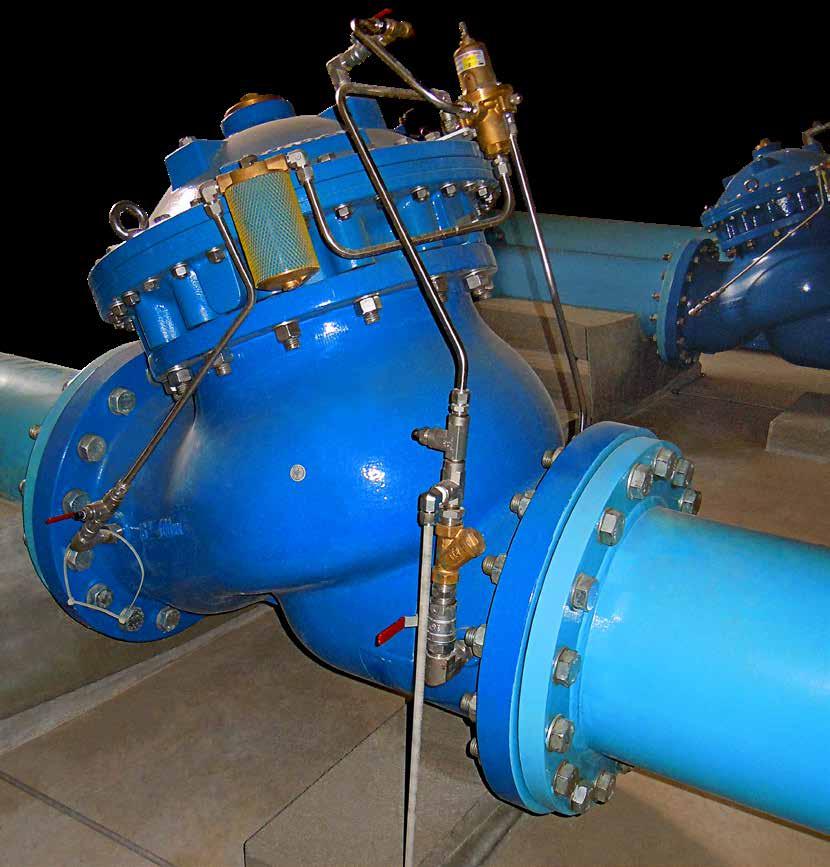
Embracing the digital utility
WATER SECURITY
Large-scale greywater reuse
COVID-19
Responding to a pandemic


















Unmet efficiency with up to 10%-20% energy cost reduction
Super high flow rate
Designed for superior cavitation resistance
High regulation capabilities









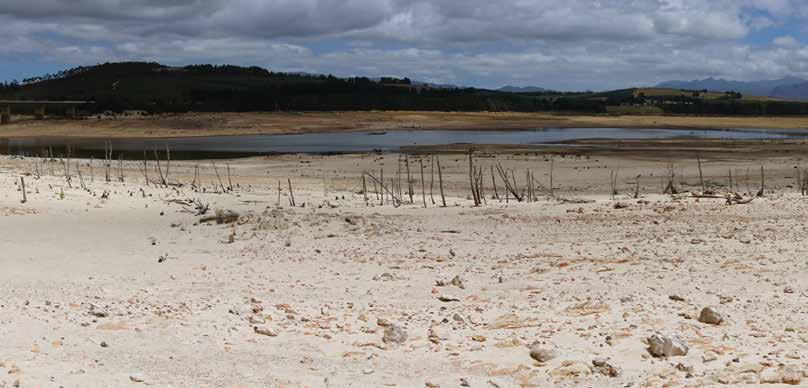
An increasing focus on environmental protection and energy savings means that water supply and distribution systems need to become more efficient and operate optimally at minimum pressures. P4

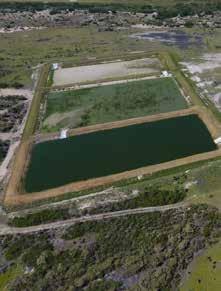

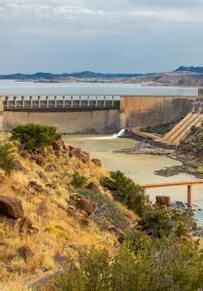

Multi Parameter Digital Level Sensor CTD (Conductivity, Temperature, Depth)
• Accuracy / Range of Conductivity Sensor:
± 1 % max. / 0,2...200 mS/cm
• Accuracy / Range of Temperature Sensor Pt1000:
± 0,1 °C / -10…40 °C
• Accuracy / Pressure Range of Depth:
± 0,02 %FS max. / 5…200 m
• Applications:
Monitoring of Water Quality and Level
• For wireless tank content measurements, optionally with conductivity measurement
• KOLIBRI Cloud compatible
• LoRa™ ready
Remote Data Transmission Solutions
• ARC-1: 3G Multi parameter modem logger or ADT-1: LoRa modem
• Data transmission via LoRa, E-Mail, FTP or SMS
• Battery life up to 10 years
• Easy to install
• Free software
• LoRa™ ready
• KOLIBRI Cloud compatible
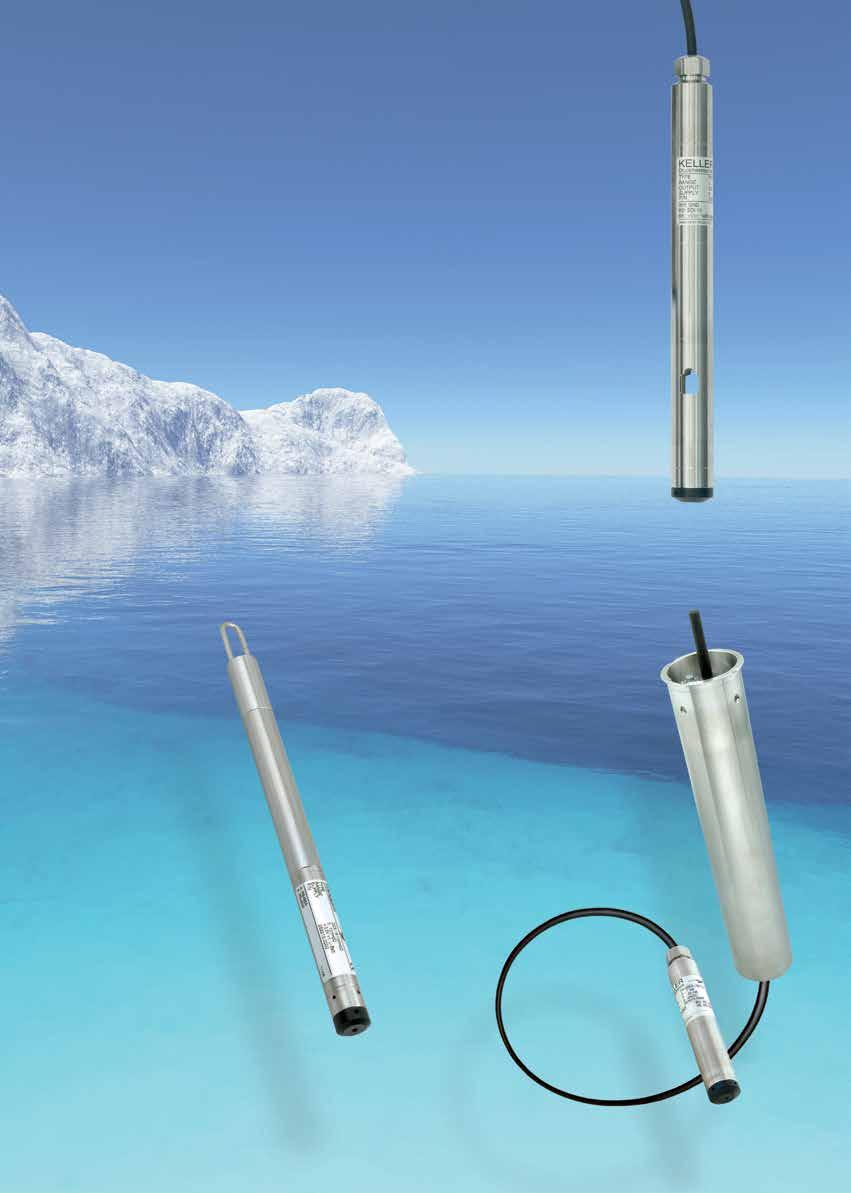
Level and Temperature Logger Solutions
• Autonomous
• Easy to use
• Battery life up to 10 years
• Applications:
· Fresh Water
· Salt Water
· Dirt Water
• Available in stainless steel, hastelloy or titanium

Editor Danielle Petterson
danielle.petterson@3smedia.co.za
Managing editor Alastair Currie
Head of design Beren Bauermeister
Designer Jaclyn Dollenberg
Chief sub-editor Tristan Snijders
Contributors Raeesa Bhikhoo, Jo Burgess, Jacky Burke, Lester Goldman, Niel Ramsay Louw, Ashton Busani Mpofu, Peter Prevos, Serigne Mbaye Thiam, Peter Townshend, Annejan Visser, Swen Weiner, Achim Wurster
Operations & production manager Antois-Leigh Botma
Production coordinator Jacqueline Modise
Distribution manager Nomsa Masina
Distribution coordinator Asha Pursotham
Group sales manager Chilomia Van Wijk
Financial manager Andrew Lobban
Bookkeeper Tonya Hebenton
Printers Novus Print KZN
Advertising sales Hanlie Fintelman
t +27 (0)11 467 6223 | c +27 (0)82 338 2266
Hanlie.Fintelman@3smedia.co.za

Publisher Jacques Breytenbach
3S Media
46 Milkyway Avenue, Frankenwald, 2090 PO Box 92026, Norwood 2117
Tel: +27 (0)11 233 2600 Fax: +27 (0)11 234 7274/5 www.3smedia.co.za
ISSN: 1990 - 8857
Annual subscription: R330 (SA rate) subs@3smedia.co.za
Copyright

WISA Contacts:
HEAD OFFICE
Tel: 086 111 9472(WISA)
Fax: +27 (0)11 315 1258
WISA’s Vision Inspiring passion for water
Physical address: 1st Floor, Building 5, Constantia Park, 546 16th Road, Randjiespark Ext 7, Midrand
Website: www.wisa.org.za
BRANCHES
Central Branch (Free State, Northern Cape, North West)
Chairperson: Dr Leana Esterhuizen
Company: Central University of Technology
Tel: +27 (0)51 507 3850
Email: lesterhu@cut.ac.za
Eastern Cape:
Branch Contact: Dan Abrahams
Company: Aurecon
Tel: +27 (0)41 503 3929
Cell: +27 (0) 81 289 1624
Email: Dan.Abraham@aurecongroup.com
Gauteng
Branch Lead: Zoe Gebhardt
Cell: +27 (0)82 3580876
Email: zoe.gebhardt@gmail.com
KwaZulu-Natal
Chairperson: Lindelani Sibiya
Company: Umgeni Water
Cell: +27 (0)82 928 1081
Email: lindelani.sibiya@umgeni.co.za
Limpopo
Chairperson: Mpho Chokolo
Company: Lepelle Northern Water
Cell: +27 (0)72 310 7576
Email: mphoc@lepelle.co.za
Mpumalanga
Chairperson: Lihle Mbatha (Acting)
Company: Inkomati-Usuthu Catchment Management Agency
Tel: +27 (0)13 753 9000
Email: mbathat@iucma.co.za
Western Cape
Chairperson: Natasia van Binsbergen
Company: AL Abbott & Associates
Tel: +27 (0)21 448 6340
Cell: +27 (0)83 326 3887
Email: natasia@alabbott.co.za
Namibia
Please contact the WISA Head Office on admin@wisa.org.za for more information

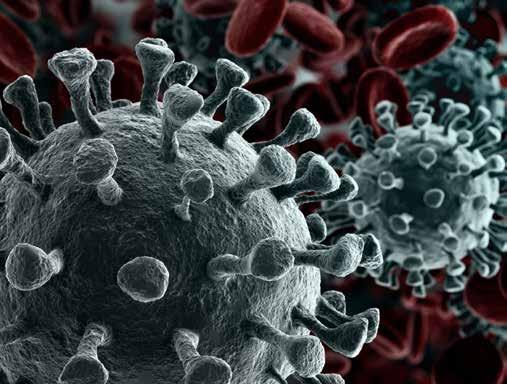
With more than 5.6 million people infected across the globe, as at the time of writing, Covid-19 has dominated the headlines for the better part of 2020. We have all been made aware of the importance of hygiene and handwashing. But turning on the tap and simply washing your hands is not a luxury afforded to all South Africans.
One of the major shortcomings the novel coronavirus outbreak has highlighted is just how far South Africa and many other African countries still have to go to ensure equitable access to water.
Don’t waste a crisis
There’s nothing like a crisis to unite people towards a common goal – Cape Town’s near miss with Day Zero is a perfect example of this. Covid-19 has highlighted just how important access to clean water and adequate sanitation is. In South Africa, we’ve seen trucks loaded with water tanks being transported to communities across the country to ensure people can wash their hands regularly in an effort to curb the spread.
Although it may not be under the best circumstances, the pandemic has forced governments to act decisively in bringing these essential services to communities.
But the concern is that once the pandemic is over and compulsive handwashing is no longer at the forefront of our minds, will those communities who have received water during this time be forgotten? Will the delivery of water stop? Or will we see our government step up and roll out more sustainable, long-term solutions?
Salga has highlighted the fact that, with three million people without access to water, the challenge is too big to be resolved
purely through the provision of water tanks and tankers. This approach is logistically difficult and expensive, costing in the region of R100 million per month and several MPs have complained that tanks in their constituencies have not been serviced or even connected.
One of the messages that emerged following Day Zero in Cape Town was the importance of suspending party politics during a crisis. The novel coronavirus pandemic offers us an opportunity to rebalance party politics with technical expertise and the needs of the country. Corruption appears to almost have become the norm for South Africa. But this is not the time to give in to the wants of politicians. Instead, we should focus on the needs of the people. Now is the time to let the technical experts guide our response as we work to rebuild a capable state. Let’s look at decentralised water treatment solutions for off-grid communities. Let’s develop attractive alternative sanitation solutions. Let’s ensure equitable water and sanitation for all. These are not luxuries – these are basic human necessities.
Thank you to our water professionals who continue to work during lockdown to provide these essential services and to ensure that our communities have access to safe water and sanitation. These are, after all, essential to protecting human life during this time.


























An increasing focus on environmental protection and energy savings means that water supply and distribution systems need to become more efficient and operate optimally at minimum pressures.
Single-chamber control valves are traditionally used in water supply and distribution systems due to their cost-efficiency; however, their functionality is limited in such low-pressure conditions.
To address this, Bermad has developed its 700 Sigma Series double-chamber control valves. These valves have a unique design only available in this series and are the same size as their single-chamber counterparts, explains Rowan Blomquist, CEO, Macsteel Fluid Control. Macsteel Fluid Control is the sole franchise holder for Bermad in Southern Africa.
These are also the only valves on the market that enable water system designers and owners to easily convert their single-chamber valves into doublechamber valves, and thus optimise their systems for smooth, accurate, secured,
stable, and efficient operations under low-pressure conditions.

Immediate response and regulating
In the case of low-pressure conditions in the network, a double-chamber valve with a three-way pilot can completely vent the control chamber, enabling the valve to open fully. This means that the valve is transparent in terms of head loss. In addition, the valve resistance becomes minor and the valve supplies sufficient pressure to consumers without creating a negligible pressure drop.
Fast, powerful, smooth
In Bermad’s 700 Sigma Series doublechamber valves, the diaphragm is isolated from the downstream pressure, which applies the valve opening force in singlechamber valves. When a double-chamber
valve is opened, the closing and opening forces on the seal disc neutralise each other.
To start the closing process, the upstream pressure water is diverted to the upper control chamber. Since there are no opposing opening forces, the diaphragm assembly and shaft move the seal disc quickly, in a linear direction and with high force, towards the seat.
When the valve is almost closed and head loss is starting to build up, the downstream pressure starts to diminish. The balance of forces on the seal disc changes and the upstream pressure causes the closing process to slow down. As a result, the end of the closing process is smooth and soft. This built-in feature is essential to modern water supply and distribution systems, as it protects them against potentially damaging scenarios such as water hammer due to valve closure.
The concept of CLAM networks has become more common and is now widely used in water utilities. This has led to increasing awareness about the slamming of pressure-reducing valves (PRVs) and is exactly where non-slam, double-chamber valves offer a vital advantage.
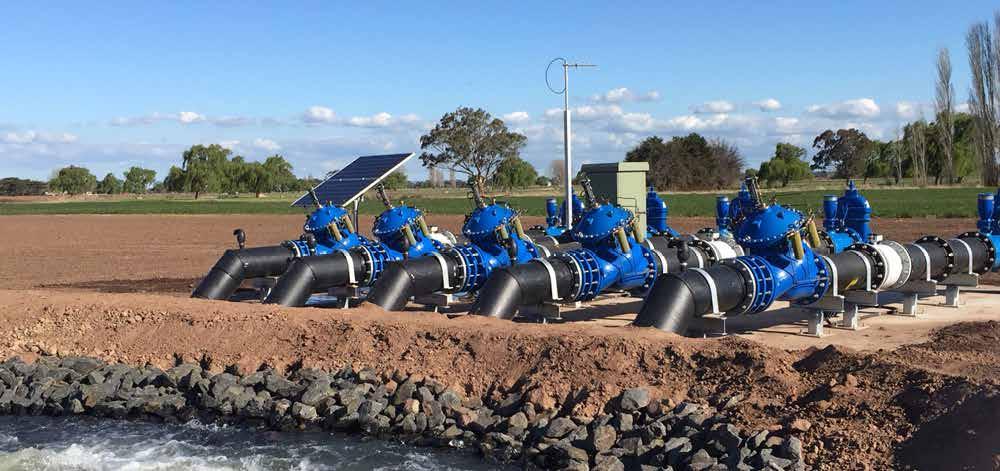

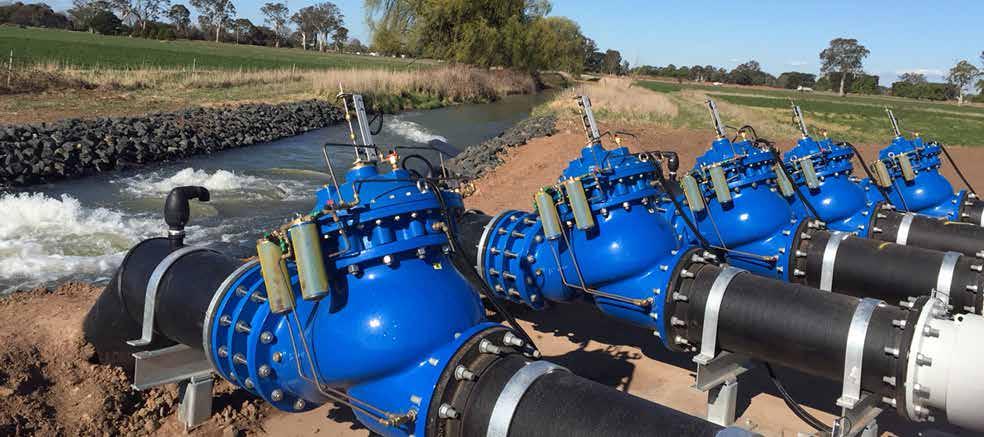
Double- vs single-chamber valve – closing speed
Opening Rate %

Double-chambered
Pressure (bar)
Proportional pressure reducing with the Bermad 720-PD Sigma
Quick reminder
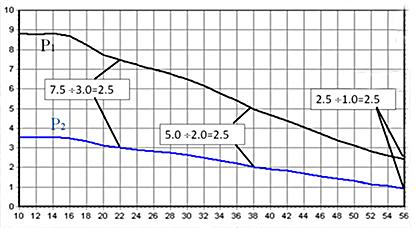
Time (sec.)

macsteel.co.za
WASTEWATER NETWORKS:
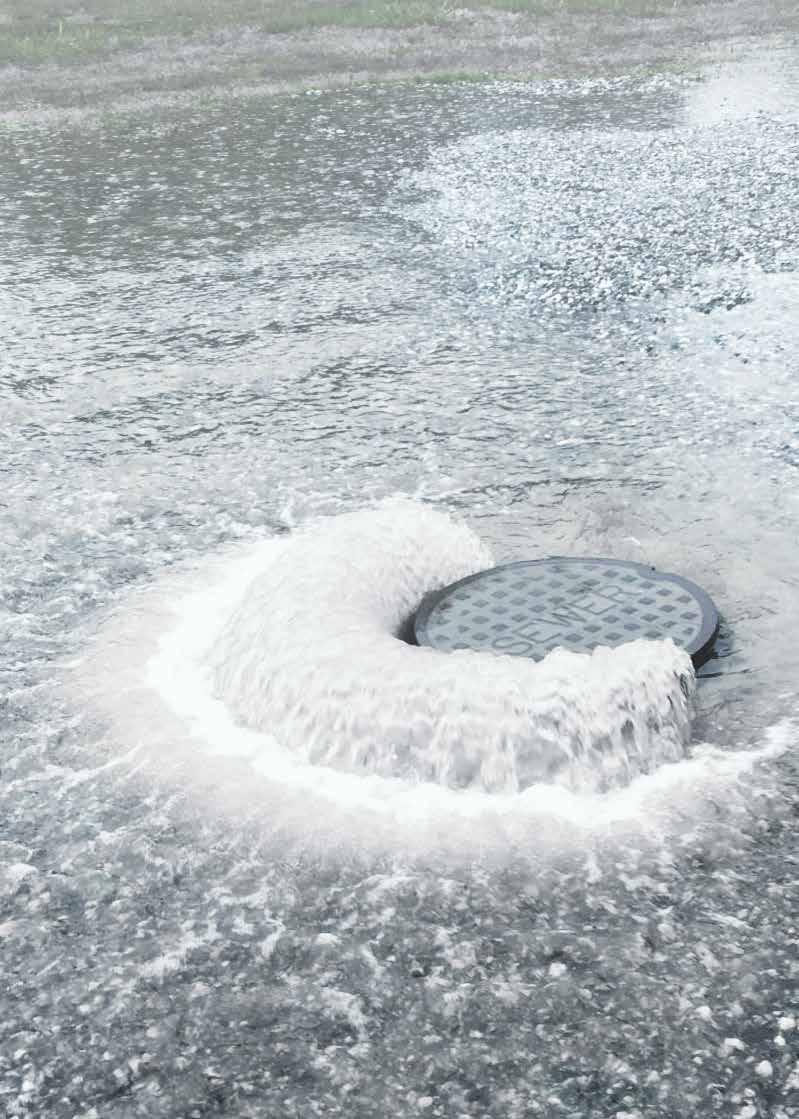
MAXIMISED RELIABILITY
EASY OPERATION REDUCED OVERFLOW RISK
GRUNDFOS iSOLUTIONS A SMART SOLUTION FOR YOU
INTELLIGENT SOLUTIONS FOR WASTEWATER NETWORKS
Grundfos iSOLUTIONS can reduce the risk of clogging and overflow in your wastewater network. The solution monitors actual flow in sewers and sends a warning in advance of high water with an indication of where the pumping system could fail. This empowers you to do maintenance before a potential overflow situation occurs, saving labour, energy and possible extensive damages to the system and the environment.
Find out how Grundfos iSOLUTIONS can optimise your wastewater network with intelligence at www.grundfos.za
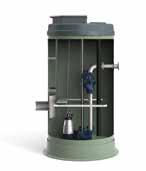
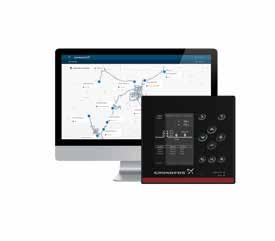


As we navigate our nation’s lockdown response to the Covid-19 pandemic, we at WISA would like to take a moment to salute the entire water sector.


We have been encouraged by the spirit of ubuntu displayed by our members. Politics and differences have been set aside and we have all worked together to ensure that all aspects of the water system are kept running smoothly. This period has not been easy for any of us, but you have stepped up to the plate and continued to provide an excellent essential service.
The race is not yet over. The strains on our economy and our families are not lessening. Businesses are failing and many people face food insecurity. But thanks to you, water has been the least of our worries. Those of us with access to running water in or near to our homes have had the assurance that the water that comes out of our taps is clean and safe to drink. You have also provided safe, clean water to many
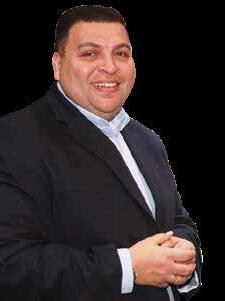
I am proud of the way the WISA office team members have shown their commitment to the sector by performing their work with the same commitment to excellence they show each day when we are all sitting under one roof
thousands of people under the most trying of conditions. And your work is not over. As the government steps up the provision of water to schools across the country, you will be there playing your part.
I am proud of the way the WISA office team members have shown their commitment to the sector by performing their work with the same commitment to excellence they show
Dr Lester Goldman, CEO, WISA
each day when we are all sitting under one roof. We have remained in touch with our stakeholders throughout the lockdown and meet virtually to discuss concerns and plan for the times ahead.
As you know, the pandemic has meant that #WISA2020 has had to be postponed to 6 to 9 December 2020. We have been encouraged by the positive feedback we have received from speakers and delegates, and are pleased to say that registrations are continuing to grow. We are confident that the meeting will be a success and are exploring new and innovative ways of meeting that will allow for top quality virtual sessions if necessary.
We would like to encourage our members and the general public even further to share some of your stories of life and work in the water sector at this time. Please let us know if you have a story to tell, and we will be in contact. Email us on admin@wisa.org.za.
Stay strong. Stay safe.
The world is in turmoil due to the combined impacts of the Covid-19 pandemic and the lockdown-induced economic crisis on people’s health and quality of life.
By Achim Wurster
The existing challenges regarding water governance and funding, together with their impacts on water security and drought resilience in the face of climate change, remain. These will be exacerbated by even greater funding challenges in future. How can the water sector address these challenges to ensure the best possible positive outcome for society?
We regularly see well-meaning attempts to address a problem causing unintended, negative side effects. Examples are present across all spheres of life:
• Covid-19: Lockdowns reduce the rate of spread of the disease. Lockdowns also destroy people’s ability to sustain themselves, as a lack of income and confinement result in overall poorer health, making people more susceptible to disease and potentially leading to higher mortality rates. Lockdowns also interrupt the supply chains required to keep essential services such as water supply operational.
• General health: The excessive use of antibiotics accelerates antibiotic resistance, which is now one of the biggest threats to global health. Healthcare errors and adverse reactions between medicines are now a leading
cause of death in developed nations.
• Economy: Governments implement excessively strict laws to regulate economic activity. As a result, the competitiveness of the economy reduces, businesses close and jobs are lost, increasing dependence on imports and, in the long term, lowering the quality of life for citizens as prices rise and income drops. To counter that, prices are fixed but, as input costs rise, products are no longer financially viable and shelves run empty.
• Environment: The removal or reintroduction of apex predators or significant grazing herds from/to ecosystems results in fundamental changes to those ecosystems. Wolves being reintroduced into the Yellowstone National Park is one well known example, while a lack of grazing and overgrazing by ruminant herds both lead to degraded grasslands.
• Water: The provision of free water to poor communities results in standpipes being left to run continuously, as there is no incentive for individuals to close the tap after use, depleting the resource and reducing the reliability of supply. In suburbs, people are told to reduce municipal water consumption; yet in many municipalities, it is illegal to use rainwater or borehole water in the home, as charges for wastewater treatment are linked to the municipal water meter reading. Building more dams in upper catchments resolves a water shortage in the upper catchment but results in shortages lower down in the catchment.
for problem-solving
A do-nothing approach is also not viable. While it prevents unintended negative consequences, the primary problem is not mitigated. We must recognise that there are almost always multiple factors at play and the optimal solution balances mitigating the problem against
any subsequent negative consequences.
In addressing problems, I have found the following principles useful:
• Every challenge is also an opportunity to innovate.
• Approach challenges like chess or Go: every decision you make has immediate and long-term strategic implications. The more options you evaluate and the further ahead you think, the better your decision is likely to be. But this must be balanced against taking too long to decide.
• There is usually no single ideal solution. All systems are interlinked, and everything is a compromise. The goal is to optimise the solution for the most positive result, using limited available resources.
• It helps to get inputs from specialists covering a wide range of disciplines, as well as from people on the ground that have experience or are living with the problem or are impacted by the proposed solution. The only way to get effective input is to have open discussions, listen to and understand other’s inputs. While doing so, we have to set aside our preconceived ideas, our egos, our various dogma and especially the outcomes that we want to see.
• We must consider all the relevant data. Since we can only manage what we measure, we need to identify and fill data
Achim Wurster, chair, WISA

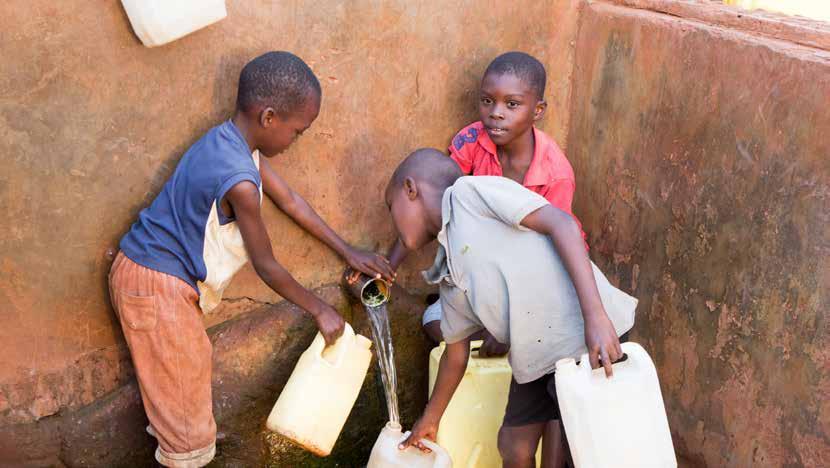
gaps. We also need to recognise that we must measure not only the problem we want to address but also the impacts and side effects. Only then, can we develop balanced and optimised solutions that are supported by data.
• Then, we have to work together as a team, pulling in the same direction, using all available tools in our toolbox to achieve a win-win outcome for everyone.
The challenges the water sector faces are numerous and largely complex. To ensure the best outcome for society, we need to constantly improve our technical, problemsolving and complex system management skills. This will ensure that the water sector is effective and efficient at addressing the challenges we face. To borrow from the WISA 2020 Conference theme, this once again requires #AllHandsOnDeck.
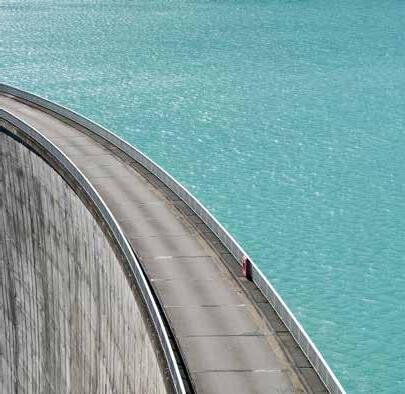





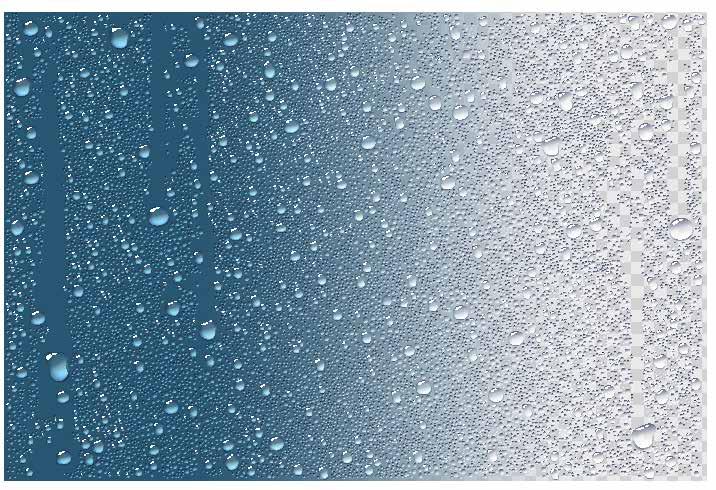
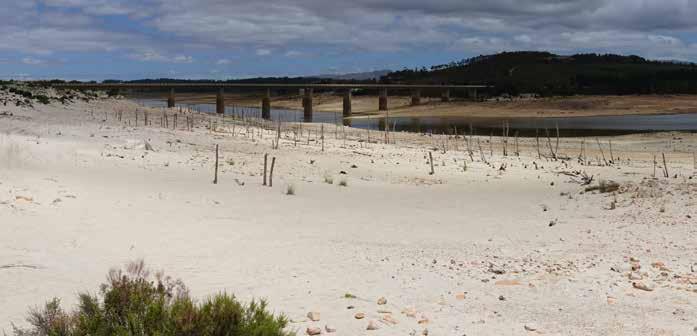
Quantity and quality. These are the cornerstones of any definition of water security: a reliable quantity and quality of water must always be available for all sectors of the country for it to be considered ‘water secure’.
By Niel Ramsay Louw, Raeesa Bhikhoo and Ashton Busani Mpofu*
For anyone who lived under the constant threat of a ‘Day Zero’ in Cape Town, or in the many other parts of South Africa that suffered equally terrible fates due to the severe 2015/16 El niño drought, it is no secret that the country’s ability to provide a reliable quantity of water and, by extension, water security has come under threat in recent years.
In February 2020, the government declared yet another national state of disaster due to recurrent droughts in multiple parts of the country, particularly the Eastern, Northern and Western Cape provinces. This coincided with nationwide power cuts as Eskom’s generation capacity dwindled. The impact of water security on the South African economy is continuously exacerbated by the recurrent energy shortages. Water and energy security are integrally linked to the country’s sustainable economy growth.
In 2019, the World Economic Forum identified the country’s water crisis as the second highest risk for doing business, further contributing to reduced levels of future investment in the economy. The recent droughts have already taken a toll on the key economic sectors of the economy such as manufacturing and agricultural, as their annualised growth rates dwindled in the last quarter of 2019 by 1.8% and 7.6% respectively (Stats SA, 2020). This was severe on the agricultural sector,
as it is the largest water user nationally, with a 62% share. The economy has been further weakened by the global Covid-19 pandemic. Water security stands out as an unprecedented important resource to stop the contraction caused by the pandemic.
South Africa’s water supply
Multiple factors have contributed to the lack of reliable water quantity in some parts of the country in recent years. Most notable is an increasing water demand due to population growth and the increase in economic activity rapidly surpassing water supply.
The country’s water supply is affected by climatic variations, saturation of water-supplementing opportunities, massive water losses due to ageing and deteriorating reticulation systems, and a lack of investment. Population and economic growth projections show that South Africa could have a 17% gap between supply and demand by 2030.
The National Water and Sanitation Master Plan: Vol 2 (2018) specifies that groundwater, wastewater reuse and desalination should increasingly contribute to the national water supply mix. But sadly, due to cost and energy inefficiencies, the potential potable panacea of technologies such as desalination is still many years away and cannot yet be considered a viable solution to the problem.
So too has the reliable assurance of raw water quality been threatened in
past years, as pollution in the vital river ways, dams and wetlands of the country has spread seemingly unmitigated. The ability to adequately treat this polluted water has waned in many areas across the country and will require investment in advanced treatment technologies. Simply stated, it is apparent that there is a substantial battle ahead of the country in ensuring a reliable quantity and quality of water – one of the most valuable resources for any country’s sustainable economic development.
The role of YWPs
However, there is one resource – often overlooked, yet equally valuable – that South Africa has no shortage of in terms of both quantity and quality: its citizens, especially the youth (ages 18 to 35 years), which forms a third of the population (Stats SA, 2019). The most affected population groups are women and the youth (Unesco, 2017). Every step towards a solution is fundamentally derived from understanding the problem. To solve our water woes, any viable solution must involve young citizens and would need broad public support – notwithstanding the fact that human influence has significantly contributed to our water crisis.
The lack of public acceptance and support of various water and sanitation solutions and/or technologies designed to improve access to water and sanitation such as dry sanitation technologies has been a major

drawback to their full utilisation. Cases of vandalism and theft of water and sanitation infrastructure cost the country billions of rand and place significant strain on the already limited budget. Municipalities struggle to normalise reduced water use among most of the population largely due to stubborn perceptions that there is ample water supply.
The implementation of water reuse is largely affected by public perception, known as the ‘yuck factor’. These perceptions and wasteful tendencies become more set as people age and are likely to be taught to the future custodians. Raising public awareness on water conservation at all levels of society to cope with its scarcity and ensure sustainability is a vital and practical approach that must precede every other solution. In 2018, the City of Cape Town succeeded in reducing its daily water usage by more than half, through public campaigns that resulted in conservative consumption by its water users.
YWPs can be instrumental in transforming societies and in addressing their own challenges, such as a lack of access to water and sanitation, unemployment and poverty. Their involvement creates a deeper, active sense of ownership, builds trust, and contributes to sustaining solutions and social capital in the community.
Furthermore, YWPs can play an active role in helping communities to learn about water security, activate their water stewardship and global citizenship. They possess youthful energy and a unique potential of connecting with their peers – the future citizens. Creating awareness among today’s youth on water conservation
and the concept of integrated water resources management will be an investment towards a water-secure future that will enhance sustainable economic development.
Today’s youth is more technologically acquainted than any previous generation and can play an active role in the transition of the South African water sector to the Fourth Industrial Revolution (4IR), which promises to revolutionise water sectors across the world. They can bridge the knowledge gap in innovation and education to build a culture of water resilience at all levels of society.
There are many methods, including: employing blockchain-based technology to improve water resources management, using the internet of things and artificial intelligence to effectively and efficiently operate and manage water and wastewater treatment utilities, creating smart cities, or making improvements in advanced materials and energy consumption that will revolutionise the desalination and air-to-water markets.
Youth empowerment and engagement as equal partners in inclusive sustainable development can fundamentally improve South African societies. However, the full realisation of an inclusive and sustainable societal development approach that involves the youth requires the provision of an enabling environment that they can thrive in.
We must do away with our notion of treating YWPs as inexperienced and immature individuals whose future we
can decide without their involvement. It is our role as a country to create an enabling environment where their voices will not only be heard but where they will be afforded an active, integral role to shape a water-secure South Africa.
In recognition of this need, WISA, under the inclusive conference theme #AllHandsOnDeck, has afforded its YWP empowerment platform an opportunity in the upcoming conference to convene and discuss the country’s water issues. This YWP forum will provide a platform for YWPs across the world to discuss and bring about innovative solutions that will feature in WISA’s position paper.
It is apparent that there is still great work ahead of the South African water sector in ensuring water security for economic development. However, as the ones who will not only inherit a possibly water-insecure future, but who will also be tasked with managing and mitigating it, it is critical that YWPs be included and allowed to play an active role in improving the country’s water security.
*The authors are all members of the YWP-ZA National Committee. NielRamsayLouwistheGautenglead, Raeesa Bhikhoo is the North West lead,andAshtonBusaniMpofu is the national lead.
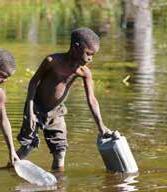
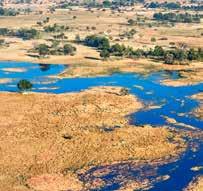
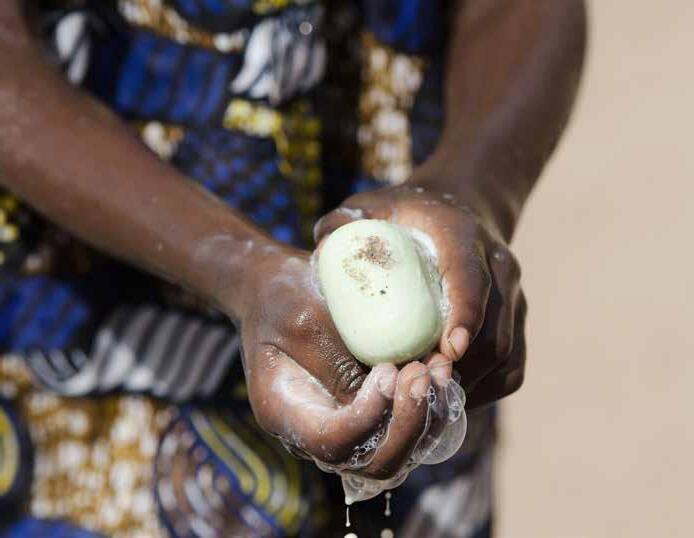


Covid-19 has highlighted the serious water challenges facing many African nations. Despite frequent handwashing being the most common advice for combating the virus, many do not have access to clean water.

Free water to beat back Covid-19

Governments failing on SDG 6
A new Afrobarometer analysis shows that there has been little progress in recent years towards Sustainable Development Goal (SDG) 6: ensure availability and sustainable management of water and sanitation for all.
In 20 out of 34 countries, majorities say their government is doing a poor job of providing water and sanitation services.

Water tankers bring water
One in five Africans who tried to obtain utility services from government during the previous year report they had to pay a bribe.
On average, more than half of Africans have to leave their compounds to access water, and only 25% have access to sewage infrastructure – a particular concern considering the importance of proper hygiene for preventing the spread of coronavirus and other infectious diseases.
The governor of Angola’s capital, Luanda, has promised the delivery of water tankers to communities.
Governor Sérgio Rescova guaranteed this during a recent visit to municipalities where he assessed the provision of free water, within the framework of the contingency plan to contain the Covid-19 pandemic.
He stated that, in partnership with the Provincial Water Company of Luanda, the provincial executive will make efforts to continue to assist the population and increase distribution in areas of where access is difficult.
As regular handwashing is a key tool in combating Covid-19, the UN and its partners are taking steps to ensure people living in informal settlements in Kenya have access to running water.
UN-Habitat said the impacts of the novel coronavirus disease could be considerably higher on the urban poor living in slums, where overcrowding also makes it difficult to follow other recommended measures such as social distancing and self-isolation.
A panel of experts from UN Human Rights Council added that it is essential for people in poverty to receive free water cost for the duration, and that public and private service providers must be enforced to comply with these fundamental measures.
Currently, a coalition of UN agencies under the banner of UN-Water is working with national and local governments, as well as civil society organisations, women, youth groups and community leaders. They are supporting a UNHabitat-led global network of smallscale water and sanitation service providers, utilities and authorities.

Word from around Africa – including the latest industry, project and development news.
Word from around Africa – including the latest industry, project and development news.

Award-winning Covid-19 project
The Integrated Urban Water and Sanitation Project for Mzimba Town, helping to curb the spread of Covid-19 in Malawi, has won the prestigious Prince Talal International Prize for Human Development.
The project is rapidly expanding access to water and sanitation to communities, while promoting good hygiene practices
such as handwashing with soap. It has increased the community’s access to potable water from 65% to 95%, raised access to improved sanitation from 45% to 97%, and created around 1 000 jobs.
Components of the project, including a community-led ‘Total Sanitation’ initiative, have helped to reduce diarrhoeal cases from 35% to 3%.
Some 10 potable water kiosks were established in nearby rural villages,


Response to Covid-19, floods and drought
Somalia has received a US$137.5 million (R2.4 billion) International Development Association (IDA) grant to respond to and recover from multiple, ongoing, and overlapping crises.
With repeated cycles of flooding and drought over many years, swarms of desert locusts threatening food security, as well as the Covid-19 pandemic, Somalia is in the grip of a climate and public health emergency.
The Somalia Crisis Response Project (SCRP) will provide immediate support to the areas hardest hit by these crises by supporting the recovery of livelihoods and infrastructure in flood- and droughtaffected areas, and will also strengthen the government’s systems and capacity
for disaster preparedness. The SCRP’s immediate response will benefit up to 1.7 million Somalis – particularly the most vulnerable populations, farming communities, internally displaced peoples, rural and urban communities, and host communities with a strong focus on female-headed households –affected by locusts and flooding.
In addressing medium-term flood recovery, the project will rehabilitate water and sanitation systems, broken or non-functioning flood control systems, health facilities, bridges, and smaller roads. Responding to the government’s urgent request for additional financing, the SCRP also includes a $20.5 million (R368 million) emergency investment for Covid-19 response.

helping to curb attacks on women trekking for water, often at night. Primary school sanitation facilities, including secured toilets, were also constructed.
The prize money of US$200 000 (R3.6 million) will go to a project implemented by government agencies, public institutions or social businesses approved by the Mzimba Town scheme.
Unsafe water raises Covid-19 risks
Long before the novel coronavirus pandemic, much of Zimbabwe suffered a severe water and sanitation crisis.
Over the last three decades, Zimbabwe has experienced a gradual decline in access to clean and safe water. From 2000 to 2017, the percentage of people with access to safe water and basic water services decreased from 72% to 64%, and basic sanitation decreased from 46% to 36%.
Over two million people in the capital city of Harare and the greater metropolitan area have no household access to safe drinking water or adequate waste and wastewater disposal services.
“Covid-19 has made an already dire and dangerous water crisis even more urgent in Zimbabwe,” said Dewa Mavhinga, director: Southern Africa at Human Rights Watch. “Failure to provide sufficient safe water would severely undermine the Zimbabwe government’s efforts to fight the virus and protect people’s lives.”
In Mutare, the court has ordered the city council to provide regular supply of potable water to its residents during the Covid-19 lockdown period, following an appeal by residents.

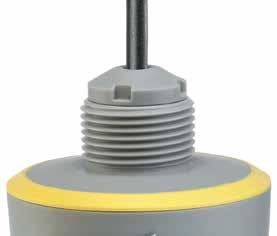
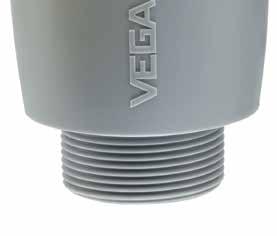
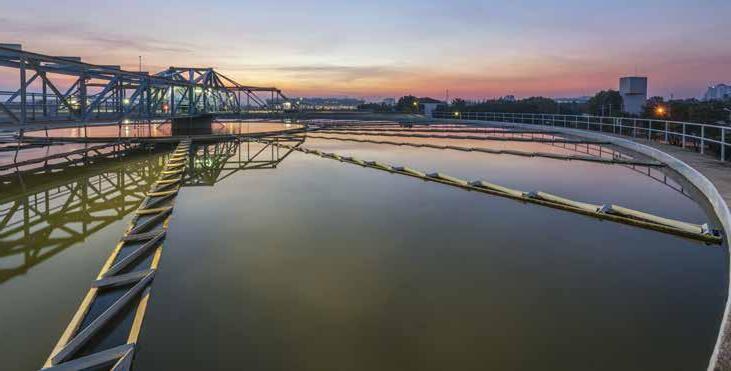
New research suggests that the SARS-CoV-2 virus can be tracked in wastewater where it may provide an early warning of the spread of Covid-19.
According to current knowledge, the SARS-CoV-2 virus, which causes Covid-19, is shed in stools. Sewage research being conducted by the Dutch KWR Water Research Institute suggests that studying wastewater may serve as an early-warning system, signalling the appearance or the return of the novel coronavirus.
The team at KWR refers to sewage as the ‘mirror of society’ because it can provide a great deal of information about the population.
Many countries, including the Netherlands, are collecting samples from their sewer networks to detect hereditary material of the virus causing Covid-19 in wastewater at treatment plants. In doing so, the entire city can be screened with one sample.
Dutch project
A study conducted by the KWR laboratory using sewage samples from seven cities and an airport in the Netherlands was able to detect SARS-CoV-2 in sewage, even when the Covid-19 prevalence is low. This indicates that sewage surveillance could be a sensitive tool to monitor the circulation of the virus in the population.
Sewage research can, for example, help determine how much Covid-19 occurs in the population and whether it is increasing or decreasing.
The initial study sought to establish a reproducible method for concentrating the virus from sewage and the isolation of RNA from the concentrate. While KWR has not yet been able to monitor the concentration of the SARS-CoV-2 M protein, this should be possible and future studies aim to improve the detection method for SARS-CoV-2, mainly for reasons of quantification.
This project aims for further screening on SARS-CoV-2 presence in sewage wastewater within a selection of large communal wastewater treatment plants in the Netherlands, in order to provide:
• trends of SARS-CoV-2 spread of the 2020 pandemic in the Netherlands
• supportive information for evaluation of quarantine/mitigation measures
• an early warning system for when Covid-19 may be on the rise again in the Netherlands
• a realistic estimate of the percentage of mild Covid-19 presence.
KWR also hopes to study other aspects, such as the density at which virus particles remain active in sewage at certain temperatures and residence times. Although studies with related viruses previously indicated that this is unlikely, this needs similar verification for Covid-19.
A new study conducted by Arizona State University researchers Rolf Halden and Olga Hart analyses what can and cannot be measured when tracking SARS-CoV-2 in wastewater. According to Halden, the population-wide screening of wastewater
makes the task of testing for the virus far more manageable, as exclusive reliance on testing of individuals is too slow, cost-prohibitive and, in most places, impractical given current testing capacity.
In the current study, researchers modelled wastewater samples in Tempe, Arizona, for the presence of the SARS-CoV-2 virus. Their work draws on computational analysis and modelling, and projections of past, present and future epidemic hotspots.
By pinpointing viral hotspots, researchers will be able to better direct resources to protect vulnerable populations through social distancing measures, while easing restrictions in virus-free regions.
A research team from the University of Michigan and Stanford University is also exploring the tracking of Covid-19 through wastewater. One of the key areas they’re exploring is whether SARS-CoV-2 can be detected in a community’s wastewater before it is known to be circulating there. The team believes the research could provide a clearer picture of how broadly the disease is spreading because it could pick up evidence of upticks in more mild cases or those that bring no symptoms at all.
Drinking water safe
Currently, there is no evidence that water is a transmission route for the SARS-CoV-2 virus. While RNA fragments of the virus have been detected in sewage water, they have a low probability of being infectious particles.
With current treatment methods, there is no evidence that Covid-19 could pose a risk via drinking water.
In the fight against the Covid-19 pandemic, a South African water services specialist has developed a GIS tool to better facilitate communication between tiers of government.
Professional water services consultant Derek Hazelton explains that the purpose of the simple, userfriendly Covid-19 GIS mapping and communications enabling tool is to allow for easier communication, in any direction, between national departments and all tiers of government, as they respond to the Covid-19 pandemic, and plan their interventions to fight and overcome it.
Facilitating closer cooperation Hazelton argues that close cooperation between National Treasury, CoGTA, the Department of Health (DoH), Department of Human Settlements, Water and Sanitation, Salga, health services at every level, water boards, CSIR, provincial and local government is essential in addressing the crisis.
“An essential piece in the jigsaw of cooperation is outstanding communication and transparency,”
says Hazelton. He believes that the DoH leads in achieving transparency but does face weaknesses in broad cooperation and formal communication. “Otherwise, communication, both formal and informal, and transparency are seriously lacking, especially as to how the command councils function, what their challenges are, and what their successes have been,” he says.
Hazelton’s goal is therefore for the tool to be used for basic visual GIS mapping by all the provincial and district command councils, and local municipalities of South Africa, so that they have a common communication language, except, perhaps, the eight metros, which are probably already using GIS mapping.
The boundaries of South Africa’s nine provinces, eight metros, 44 district municipalities (DMs) and 205 local municipalities (LMs) have been plotted
Derek G Hazelton, Pr Eng., FWISA, founder and manager of TSE Water Services

using Google Earth Pro. Thus, the records of the Covid-19 cases and the hotspots will be visibly located in each of the 257 municipalities. Ward boundaries, the boundaries of Stat SA’s main places, sub-places and any other boundaries or names that users wish to add can be included.
Hazelton chose Google Earth as the vehicle to launch the tool because it is freely available and easy to use. This makes it an ideal communication tool for all tiers of government, but especially for poorer municipalities.
The tool has been designed to plot the location of hotspots and to receive and update data on these hotspots, from any source. It can also receive and update data on the location of Covid-19 cases, and other information such as deaths.
Hazelton also sees the tool as being useful in other areas after the pandemic. Prior to the novel coronavirus outbreak, he was at an advanced stage of assembling a small team to respond to the National Water and Sanitation Master Plan’s Call to Action.

“We planned to facilitate and coordinate the implementation of water services authority (WSA) turnaround programmes. The programmes encompass WSA capacity building, community employment creation, improved wastewater management, reduced water leakage from water systems, and the financial strengthening of WSAs.
“The implementation of the proposed mapping and communications enabling tool, apart from supporting government’s Covid-19 response efforts, will also build a useful foundation for implementing the WSA
turnaround programmes, once South Africa and the world return to a new normal,” he says.
Commenting on water supply interventions during the pandemic, Hazelton expresses concern that interventions appear to be limited to the installation of water tanks, which are subsequently being filled by water tankers. Tankering, he says, “is costly and therefore not sustainable”.
He draws on his experiences as the Water Supply Task Force Coordinator for the National Consultative Forum on Drought in 1992/93. During the 1992/93 drought, efforts quickly moved from tankering to refurbishing old boreholes and drilling new ones. Today, with many more households having piped water, fixing visible leaks on distribution systems and from fixtures on private property also needs to proceed immediately, so that downstream users, without water, receive a supply. “Fixing these leaks will create employment – another
aim of the 1992/93 Consultative Forum on Drought, which is still indispensable today. Under these circumstances, none of the 15 000 young graduates of War on Leaks programme should be without a job,” says Hazelton.
While the 1992/93 interventions were highly beneficial to all stakeholders, they did not lead to sustainable supplies, because there was no follow-up, he explains. “The same situation is likely to apply today, in 2020.
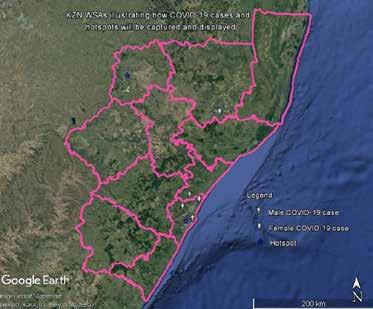
A very comprehensive follow-up in line with the National Water and Sanitation Master Plan’s Call to Action will be required to turn around the current water services crisis that already existed before Covid-19.”
KwaZulu-Natal’s WSAs, illustrating how Covid-19 cases and hotspots will be captured and displayed
Formoreinformation,contact DerekHazeltonontsewater@icon.co.za.
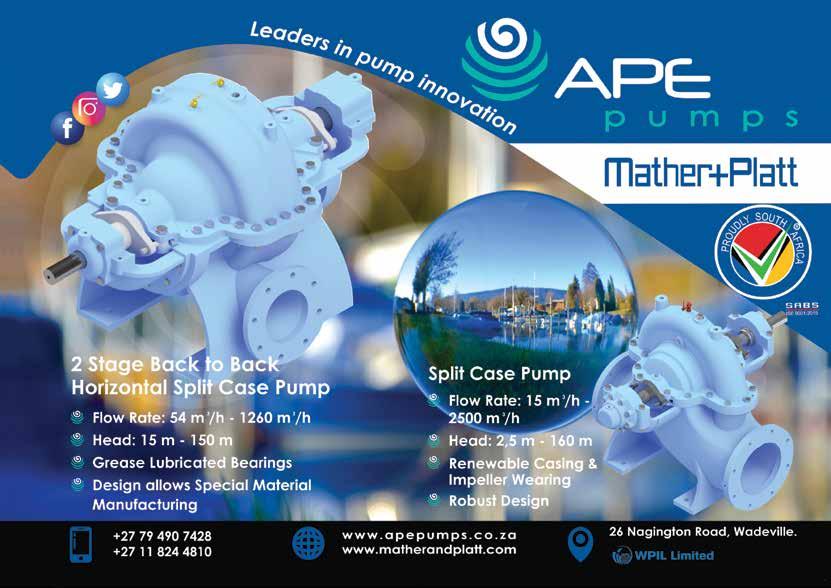
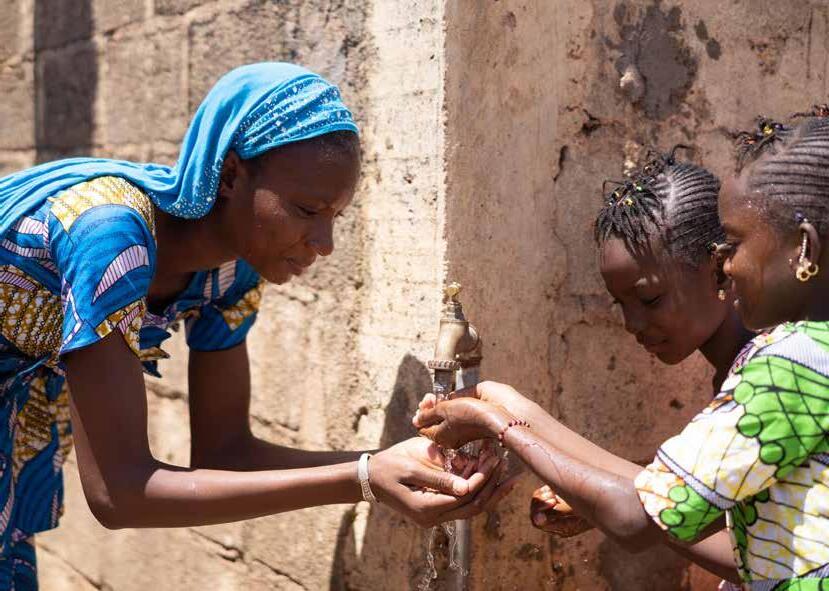
Water usage patterns have changed all round the world due to populations in lockdown spending more time at home.
By Dr Jo Burgess*
The morning ablution peak has shifted to late morning, and domestic water consumption has increased by 15% to 25%, while non-domestic has decreased by 30% to 50%. In Africa, this is a critical issue because there are fewer domestic customers on metered water connections than elsewhere in the world, which means that a much higher proportion of the water that water service providers are supplying is not being paid for. The result is depressed revenue at exactly the time when utilities desperately need income to extend water and sanitation services to unserved communities.
Covid-19 response challenges
Africa has issues of managing Covid-19 in communities that do not have access to running water, and do not have the ability to self-isolate. Consider the minimum requirements for a lockdown to be effective: access to safe drinking water in the home; access to adequate sanitation in the home; a source of reliable energy; access to information or communications technology; and having
a permanent source of income or savings.
If the first three requirements are not met, then almost all household members will need to make multiple daily trips to places where other people congregate, such as communal taps and communal ablution blocks (CABs). Seemingly simple steps to battle the spread of Covid-19, like regularly washing hands with soap and water, present fundamental challenges.
While facing the global issues of sourcing personal protective equipment, social distancing and operating with a scaled-back workforce, the African water industry has mobilised to assist the poorest customers, both domestic and commercial, with access to a supply of safe water. In South Africa, organisations have banded together to provide resources like multilingual advice for people using CABs. The Department of Human Settlements, Water and Sanitation has procured 41 000 water tanks and is providing them to small or rural municipalities to enable them to supply potable water to unserved communities.
Most utilities, for example in Ghana, South Africa, Malawi and Uganda, are supporting the vulnerable and are trying to remobilise their capital programmes.
Research-wise, the monitoring of genetic material from the inactive virus found in sewerage systems could provide a rapid early detection method to identify its presence in communities and lead to targeted lockdowns.
This approach, often termed wastewater-based epidemiology (WBE), has some potential advantages over case-by-case tracking, including improved throughput at the community level and tracking asymptomatic cases. This is a hot research topic right now, with universities, utilities and

Dr Jo Burgess
A WhatsApp group intended for a handful of utilities to share learnings and experiences of the Covid-19 pandemic has quickly scaled to involve over 260 organisations.
Dr Piers Clark, founder and chairman of Isle Utilities, started the chat group in March when lockdowns required utilities to respond rapidly to multiple unprecedented challenges. The group includes 41 African organisations – 21 municipalities, 17 water boards and water and sewerage companies, two water service provider associations, and a national water authority – from eight countries, with 68 individual members. To help curate the rich stream of information shared in the WhatsApp group, Clark hosts a weekly webinar on Thursdays at 08:30 and 17:30 (SAST) to accommodate global time differences.
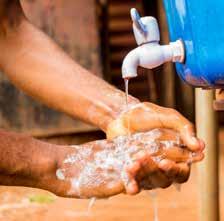
Clark says issues on the technical side have been around the contamination and reuse of personal protective equipment, asset management and the impact of changes in demand on models for water network management. More recently, people are asking about modelling of the financial impacts on organisations and changes in the way rates are charged and collected.
“Covid-19 is affecting everyone, and if ever there was a time for collaboration, this is it. The ability to communicate between colleagues within utilities has always been quite good, but what we are seeing now is that walls between utilities have crumbled,” says Clark. To register, visit www.isleutilities.com/events or email piers.clark@isleutilities.com.

research centres in Australia, Egypt, France, Mexico, the Netherlands, South Africa, the UK, the USA and others collaborating in the race against time to develop a reliable WBE programme.
It is critical to note that these detections do not represent a culturable virus in the wastewater that would be necessary to cause infection. Separate research is being conducted to assess the presence and persistence of the severe acute respiratory syndrome coronavirus-2 (SARS-CoV-2), which causes Covid-19 disease, in wastewater and any disinfection required.
*DrJoBurgess isatechnicalconsultant atIsleUtilities.
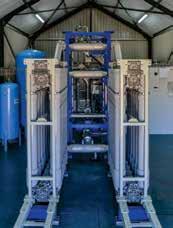

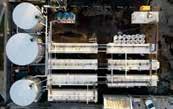


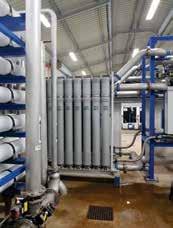


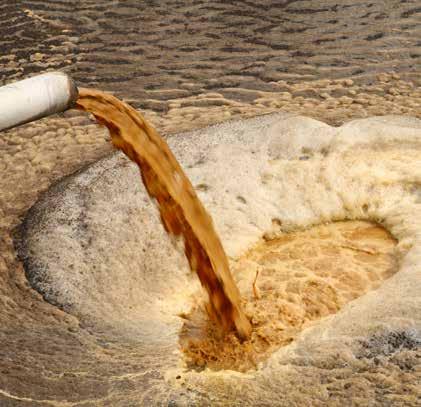
South Africa’s ailing wastewater treatment works are becoming a significant concern for public health and safety.
By Danielle Petterson
Approximately 56% of the more than 1 150 municipal wastewater treatment works (WWTWs) in South Africa are in a poor or critical condition and in need of urgent rehabilitation as well as skilled, registered process controllers.
According to the National Water and Sanitation Master Plan (NW&SMP), approximately 44% of the country’s 962 water purification works are in a similar position, and 11% of all treatment infrastructure is completely dysfunctional.
The NW&SMP explains that the failure of some municipalities to provide reliable water and sanitation services is largely due to the lack of technical skills, institutional capacity and funding to operate, maintain and manage water and wastewater infrastructure assets.
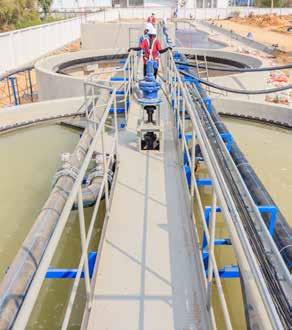
Ayesha Laher, director, AHL Water, identifies several of the major problems she sees facing our WWTWs. The first is a lack of motivation to change the current status quo due in the absence of punitive measures in response to legislative noncompliance. Another is a lack of leadership with the necessary technical skills to implement sustainable solutions, along with insufficient operational resources. Like the NW&SMP, Laher also identifies a lack of maintenance programmes, as well as incident reporting to ensure effective asset management.
Marlene van der Merwe-Botha, director, Water Group Holdings, cautions against generalising the problems or singling out a particular problem. Each plant has its own specific risks and set of challenges that contribute to noncompliance. These can range from limited plant capacity to a lack of capital for upgrades or renewals, a lack of operational budget or human resources, ageing or non-functional assets, a lack of performance management, and inadequate or inappropriate design and technology.
Van der Merwe-Botha does, however, concur that the one problem underlying most of the challenges at WWTWs can be reduced to skill, experience, competency and caring.
While Van der Merwe-Botha believes that appropriate technologies are predominantly employed at most WWTWs, she argues that the skills do not always complement the technology and, subsequently, the technology underperforms against its initial design expectations. In cases where inappropriate technologies are used, this is usually due to
project managers and municipal officials lacking the know-how to specify and/or implement the appropriate technology.
She calls for a back-to-basics approach. “Many plants are just battling with the basics, and telemetry, Scada and other automation technologies are often defunct or unused – and not of direct benefit to the daily operations. Having observed this, we note that automation is well applied at capacitated municipalities with knowledgeable and well-trained technical staff, to the benefit of operational control and meeting compliance targets.”
Laher also sees room for automation to enhance water and wastewater management, in particular the operational control of collection and supply systems. This can allow for quicker reaction problems and improved performance. However, she cautions that while new technologies must be embraced, one must ensure the technology is appropriate for local conditions.
One way to address some of these challenges is through focused skills development. “We need academic and theoretical knowledge to be translated into practical know-how. Universities and colleges need to bridge the gap from tertiary level into the workplace and the workplace needs to employ experienced, capable plant managers to mentor, guide and teach process controllers on the job,” says Van der Merwe-Botha.
She stresses that professional wastewater practitioners need to be appointed on merit, irrespective of other criteria, and calls for young professionals and students to be brought back into learnerships under capable mentors.
Laher adds that while there are many skilled process controllers in South Africa, they need to be capacitated by management to do their work. “We need skills development of senior management including project management units, technical directors, procurement and councillors so they can make the right decisions and understand the consequences of their inaction.”
Upon launching the NW&SMP, Minister of Human Settlements, Water and Sanitation (DHSWS) Lindiwe Sisulu announced that her department would revitalise the Blue, Green and No Drop monitoring programmes. The master plan states, “To date, one of the more successful and informative regulatory programmes
was the Blue Drop and Green Drop certification.” Unfortunately, no Green Drop reports have been released since 2014, leaving a significant gap in the industry. Van der Merwe-Botha reiterates that this gap encompasses many areas, which include the availability of credible data, self-motivation and self-regulation by municipalities to perform and comply, secondary industries and economies such as laboratory analysis, research and application of disruptive technologies, and collaboration and sharing between government departments with shared wastewater services quality objectives.
“Since Green Drop certification was suspended, the vast majority of municipalities have failed to conduct and submit monthly compliance data to the DHSWS as per section 62 of the Water Services Act (No. 108 of 1997),” says Laher. The Green Drop system was replaced by the IRIS system for submission of compliance data to the DHSWS. However, the IRIS system only reports on effluent quality compliance data submitted and does not allow for trend analysis over time.
Laher and Van der Merwe-Botha both agree that the Green Drop (as well as the Blue Drop) programme should be reintroduced. The award-winning Green Drop programme – which provides legislative and best practice guidelines for the operations and management of WWTWs – received international praise.
Citing the Green Drop results from 2009 to 2014, Van der Merwe-Botha says, “Never had we (South Africa) seen such a drastic influx and improvement in know-how, compliance, caring, budget, skills and positive attitudes flooding a single sector as during this time. The positivity, energy and drive for progressive improvement by municipalities made this one of the most exciting and progressive periods in the history of South African water and wastewater and the people serving in this industry.”
According to Laher, this can largely be attributed to the incentive-based approach of the Green Drop, which appealed to a sense of pride among municipal officials, leading to a top-down, proactive approach to ensure Green Drop compliance – which translates directly into efficient WWTWs and good-quality effluent.
The programme stimulated a healthy competitive environment in which municipalities not only competed for the best scores, but also assisted and supported each other to achieve higher
scores through knowledge-sharing and peer exchange.
“The secret of the ‘Drops’ lies in its design and implementation, which ensured nationwide buy-in and desire to participate. It comprises a well-designed audit scorecard, implemented by highly competent and trained inspectors through a process of consultative auditing, thereby allowing inspectors to guide and transfer knowledge to municipal teams during the audit process,” says Van der MerweBotha, adding, “We cannot afford not to reintroduce the Green Drop.”
Ultimately, if the problems at many of the country’s WWTWs are not addressed, it is the health of the public and environment that will suffer. The cost of water and health will likely escalate, and negative impacts will be felt by the economy.
“Our water treatment plants are not designed to treat wastewater. If we do not repair our WWTWs, our WTWs will fail and the health of our citizens will be negatively
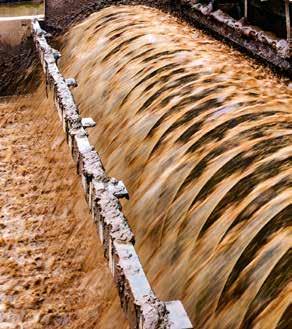
impacted, especially vulnerable groups,” stresses Laher.
Van der Merwe-Botha concludes: “If we carry on as is, and the regulators continue to delay their regulatory duties (such as reintroducing the Green Drop), we will not be having debates about whether South Africa is facing a crisis. Instead, we will be living that crisis in the same way that we live with Covid-19 now.”



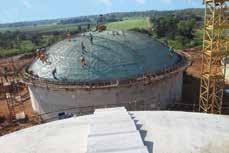
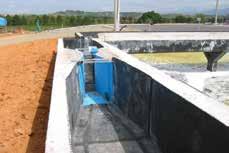
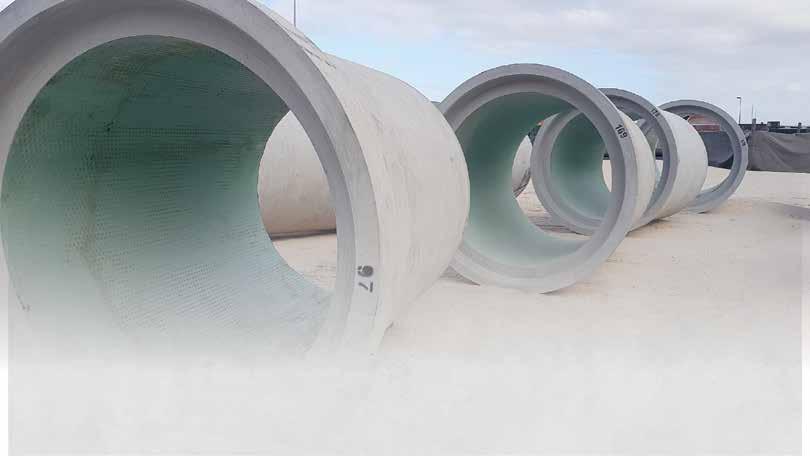
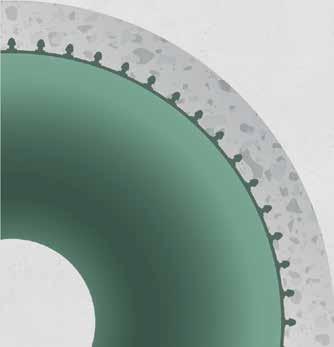
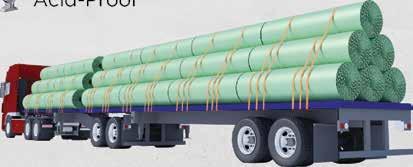


Concrete is the structural material of choice for pipes, bunds and reservoirs in wastewater treatment plants. The addition of HDPE liners can protect concrete, ensuring greater longevity.
Concrete, a versatile and age-old material, presents one serious and costly drawback: it is susceptible to degradation in modern, aggressive environments.
Concrete corrosion due to chemical attack can significantly reduce the lifespan of unprotected concrete structures, such as pipes used in wastewater treatment works. This often necessitates disruptive and costly replacement operations for municipalities and facility operators.
Sophisticated cast-in corrosion protection liners (CPL), such as those manufactured by AKS Lining Systems, effectively prolong the lifespan of new pipes, bund areas and reservoirs, dramatically reducing the lifetime cost of water treatment infrastructure.
AKS Lining Systems has taken the cast-in liner concept and perfected its design through the development of Anchor Knob Sheet (AKS™) technology. The concept surpasses all concrete protection alternatives both in cost saving and performance.
AKS CPL, manufactured from HDPE, was designed specifically for the conveyance of sewage and is supplied in wide sheets, tubes or rolls to suit the project requirements. In the case of concrete piping, the concrete pipe manufacturer

integrates the tube with the concrete during the casting process. The unique anchors are embedded into the concrete, so that the tube forms an integral part throughout the length of pipe.
In this way, AKS CPL enhances the robust qualities of HDPE linings through the close matrix of anchors. These anchors permanently secure the sheeting to the structure.
AKS CPL is unique in its design. A total of 1 230 anchors per square metre ensure the lining is locked firmly into the concrete structure. Supplied in thicknesses from 1.65 mm up to 10 mm, the liner is used in a diverse range of chemically aggressive applications such as mining, water treatment and sewage conveyance.
Once anchored firmly into the structure, AKS CPL offers a chemically inert, flexible skin. The liner offers high abrasion resistance, is acid-proof and offers long life expectancy in the harshest environments. Its superior crack-bridging ability allows for movement in the concrete structure, without delamination.
The use of HDPE AKS CPL in conventional concrete pipes enables these pipes to be used in applications where only GRP, PVC or solid wall HDPE pipes would have been
considered previously.
An AKS-lined concrete pipe offers numerous benefits: chemical resistance to nearly all aggressive environments; no limit to the size or diameter of the pipe; the smooth HDPE internal surface offers far higher friction values for additional carrying capacity; high abrasion resistance ensures minimal damage or wear and tear; and the overall cost of large-diameter AKSlined pipe is greatly reduced compared to alternatives.
AKS CPL is manufactured at AKS Lining Systems’ large production plant in Brackenfell, Cape Town. A yard with ample storage provides the shortest possible lead times to customers.

For further information, email info@aks.co.za or call +27 (0)21 983 2700. AKS invites its customers to a plant visit to familiarise themselves with the integrity and quality standards at work at the company.

As Southern Africa faces a growing wastewater crisis, engineers and representatives from KSB Group companies have committed to finding workable solutions.
Governments and municipalities across Africa are grappling with ways of dealing with growing wastewater requirements, and it has become increasingly evident that a onesize-fits-all approach does not work. Differing conditions – such as sand content, water quality and existing infrastructure – play a large role in the specification of future pumping infrastructure requirements. This has prompted the KSB Group to play a more active role in assisting wastewater entities and to lend its technical expertise through its extensive network of regional companies, branches and dealers that are well established in every country in sub-Saharan Africa.
Strategic training
Preparations to support the intensive new wastewater drive got under way at the regional office of KSB Pumps and Valves in Johannesburg recently, when global expert Ben Harrison – regional application manager: MEAI KSB Global Corporate Water Department, from Germany Halle (Saale) – led a two-day workshop aimed at sharing countryspecific information and devising ways of working with authorities to provide wastewater solutions.
“As one of the largest pump companies in the world and a major role player in Africa, we are listening to the needs of the market and taking info from our representatives in each region to our technical department to find pumping solutions for each district,” he says.
“We want to bring international standards to local solutions and provide the kind of wastewater solutions that are affordable, durable and appropriate for the kind of maintenance and support available in that particular area.”
KSB is well entrenched as a main supplier of potable water and other
fluid transfer solutions to governments and utilities in many African countries. It therefore makes sense to expand support and solutions for wastewater applications.
“KSB has the support and expertise to support plans to deal with future wastewater requirements. We understand that expectations don’t differ by country and we assure customers that the knowledge required for engineers in KSB is the same in every country,” says Harrison.
KSB sales engineers are able to discuss requirements on equal terms with engineering teams and can call upon local and international expertise to find the right pumping solutions for the right job.
Now that the company has assembled its internal staff and put in simplified structures to support wastewater pumps in each region, it can be expected that it will hit the ground running and make significant inroads in a market that currently does not enjoy the attention of other large pump manufacturers. In South Africa, KSB also has the advantage of being a Level 1 BBBEE contributor.
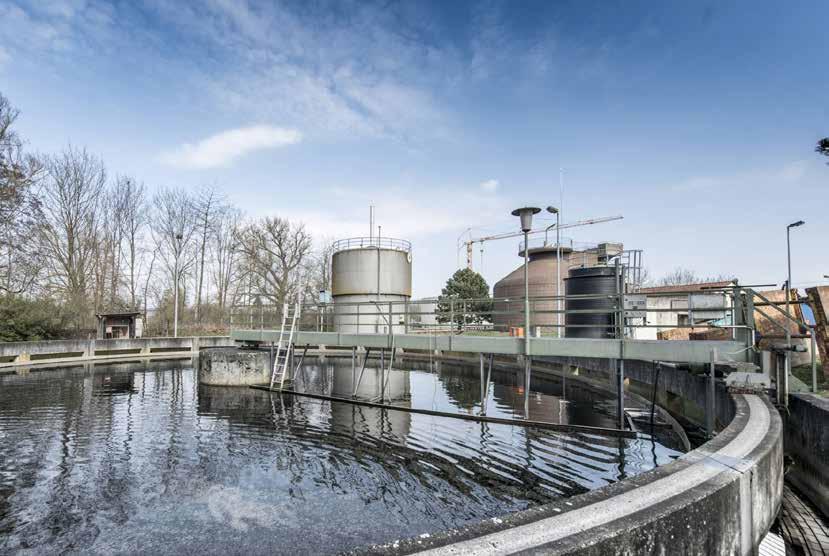
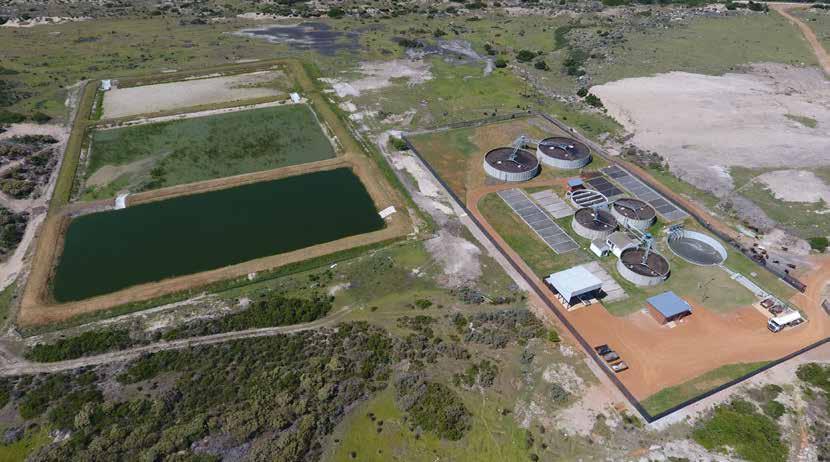
The Kouga Local Municipality is proactively providing infrastructure for future economic growth in the area. In line with this, the St Francis Bay Wastewater Treatment Works (WWTW) has been upgraded from 750 m3/day up to 2 000 m3/day. The upgrade also ensures that the effluent discharged from the WWTW complies with relevant standards.
The plant serves the growing communities of St Francis Bay, Cape St Francis and Sea Vista, and will cater for future development in the area. It was originally built by Prentec in 1995 and has undergone two subsequent capacity upgrades of 250 m3/day, each in 2000 and 2007.
The upgrade
Prentec was appointed as the main contractor on the upgrade project and SRK Consulting as the consulting engineer. The plant upgrade included the refurbishment of the existing works, covering civils, mechanical and electrical.
Local labour was used as much as possible, with a total of 44 639 worker hours completed by local labour on the project. In addition, local subcontractors and suppliers for services and materials
PROJECT TEAM
Client: Kouga Local Municipality
Main contractor: Prentec
Consulting engineer: SRK Consulting
SUBCONTRACTORS
Civil earthworks: SP Excel
Electrical installations: Servelec

were sourced and employed. The project took place over two years – from February 2018 to February 2020. In order to manage the client’s budget, this spanned three financial year periods. “The project was split into three portions, each to be completed within the respective financial period. Portion 1 was the refurbishment of the existing works; Portion 2 was the construction and commissioning of the new plant equipment; Portion 3 was the construction of the wetland area for the plant discharge, including fencing and landscaping of the area,” explains Duncan Klinkert, project manager, Prentec.
The hydraulic loading on the treatment works is extremely seasonal. The town has a permanent population of approximately 10% of the peak holiday population, and therefore experiences peak loading over the Christmas holiday in December and January, and over the Easter holiday in April.
Tiaan Claassen, principal engineering technologist, SRK Consulting, says that various technologies were investigated for the upgrade, but it was concluded that it would be in the best interest of municipality to use the cost-effective technology currently used – namely sequential batch reactors (SBRs), which may be classified as extended aeration activated sludge technology. This technology was also considered favourable, as the plant operators were already accustomed to the existing plant’s operational processes and procedure.
The Prentec SBR process treatment is based on total oxidation by the extended
The capacity of the newly upgraded St Francis Bay Wastewater Treatment Works has been significantly increased, allowing for future growth and ensuring effluent compliance.
aeration principle of the activated sludge process and may be described as a controlled biological process where the aeration of the mixed liquor, as well as the settling and decanting of the treated effluent take place in a single reactor.
This technology offers many advantages, including: being more environmentally friendly; reduced capital costs; improved plant reliability, performance and operational control; reduced sludge volumes; and reduced labour and maintenance needs. Batch plants are also constructed in a modular fashion, allowing for easy and costeffective plant extensions.
The Kouga Local Municipality has been operating the plant since its inception in 1995, and the original plant operator is still working at the plant. The upgrade employs the same principles and technology that enable an ease of operation by the client.
The addition of new technology and automation systems through a computerised Scada system and mechanically operated inlet works screens allows for a larger plant to be more readily controlled. Prentec provided training to five plant operators, including theoretical and practical training.
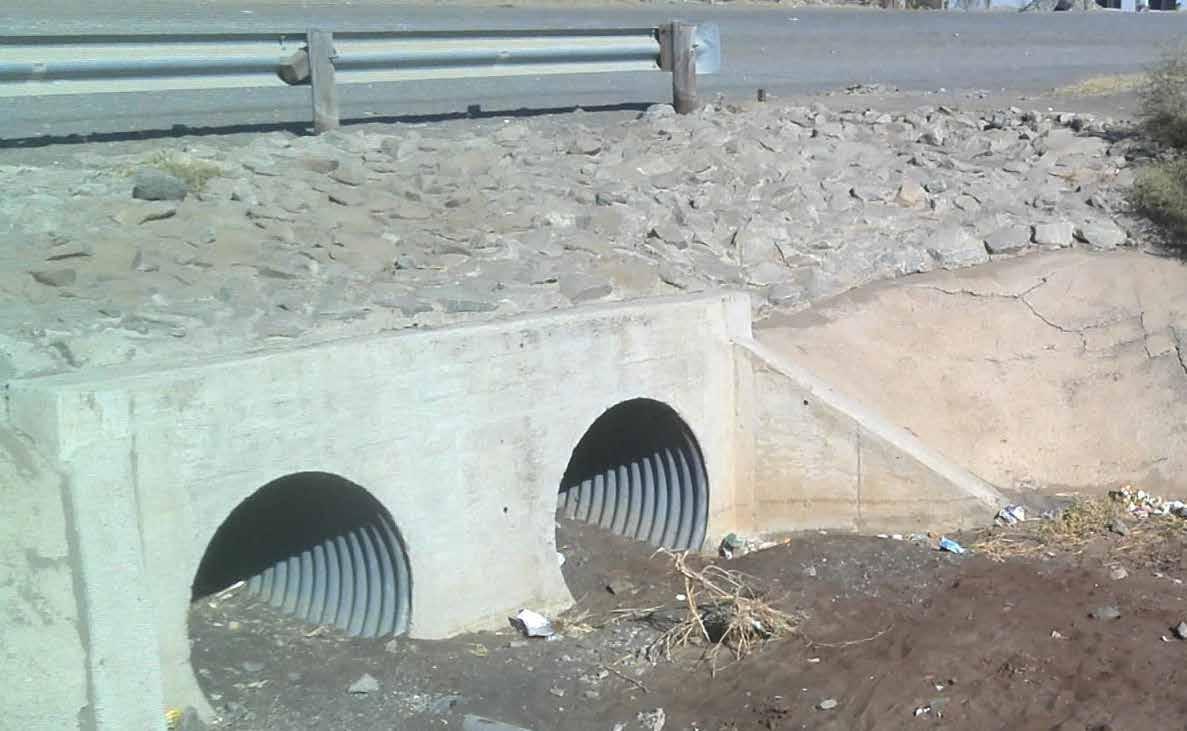
The stricter regulation of water use has become both a social and environmental imperative for South Africa, and the country is gradually coming to grips with what this means in practical terms – with the processing of water use licence (WUL) applications showing both progress and challenges. By Jacky Burke*
Following the governmentissued regulations on WUL applications in 2017, one of the initiatives by the Department of Human Settlements, Water and Sanitation (DHSWS) to streamline the WUL application process has been the department’s launch of its Electronic Water Use Licence Application and Authorisation System (Ewulaas), which has certainly been an improvement over the previous paperbased system.
There is still some way to go, however, in establishing a smooth and wellresourced system for managing the scale of WUL applications, and stakeholders are, at this stage, trying to collaborate as closely as possible to ensure that application timeframes are met.
One of the most important contributions of the 2017 regulations was to put in
place a clear process and timeframe that stakeholders could understand and to which parties (both the applicant as well as the authorities) could be held accountable. The aim is to complete a WUL application in a structured 300-day process, which is spilt between 146 days for applicant processes and 154 days for the DHSWS’s review and decision process.
The capacity constraints are reflected in various delays still evident in the system, such as the lags that may occur in the issuing of the department’s letter of acceptance of an application. This problem results, for instance, in time being lost between the applicant’s allowed time and the department’s allowed time. Specialists in the DHSWS – based mainly at national level – are also under extreme pressure from the sheer number of applications coming from regions, and this can often create a bottleneck in the process.
The Ewulaas system has streamlined efforts considerably, providing a userfriendly platform to walk applicants through the submission process and allow for the digital uploading of all necessary documents. There remain various technical challenges from time to time, however, where the system’s functionality is not always optimal – creating difficulties for both the department’s officials and the WUL applicants.
What is apparent at this stage is that the process still requires vigilance and careful monitoring to keep WUL applications on track. Applicants and their consultants need to establish and maintain strong communication channels with the relevant DHSWS officials – including case officers where possible – to track progress in applications and to iron out problems where these occur. This is a natural
part of evolving a functional and efficient system. There is clearly still scope, however, to build the capacity within the department itself – including the sheer numbers of qualified professionals required.
Part of the continuous improvement of the Ewulaas system could also include simplifying the data requirements at upload stage. The length of application forms – running to multiple pages per water use, for example – imposes considerable investment in time and costs that could be avoided. These costs are raised significantly when the online system fails, and data cannot be uploaded or is lost. This requires frequent reworking on the part of applicants or consultants. The department has demonstrated that it is committed to improving the system; and as consultants, we offer regular and constructive comment.
The close contact between consultants, their clients and the DHSWS is in part necessitated by the intrinsic complexity of water management – and hence of the data required in a WUL application. Where officials have queries or require gaps to be filled, it is vital for these matters to be taken up promptly and addressed; this way, the projects that depend on the WULs will not be unduly affected or delayed. Here, consultants play a valuable role in ensuring speedy responses, especially where the applicant’s own resources are stretched. It is worth mentioning, however, that while some officials are happy to work with

consultants on the client’s behalf, others prefer dealing with the applicant directly. As the application process becomes stricter, the DHSWS is requiring more detailed information on project design in the WUL application. This is placing increasing demands on the applicant, and we advise clients to advance their project planning to a certain level of detail to ensure greater completeness in their WUL applications. This ensures that the application is made only once the scope of the project is fully defined; by ‘freezing’ the project scope, there is less chance that design changes made at a later stage might force the application to be reconsidered from scratch. If that happens, the intended efficiency advantage of submitting an application early is lost.
Recent weeks, following the outbreak of the Covid-19 pandemic, have shown that the country has much work to
do in addressing the risk of infectious diseases. Part of this response will include government measures to allow civil servants to work in isolated environments, while still delivering the services that the country requires. The DHSWS will be no exception, and the WUL application system – enhanced by Ewulaas – will need to be further adapted to meet this challenge.
*JackyBurkeisa principalscientist atSRKConsulting withover 30yearsof experience inthefields ofwateruse authorisation andintegrated waterquality management.


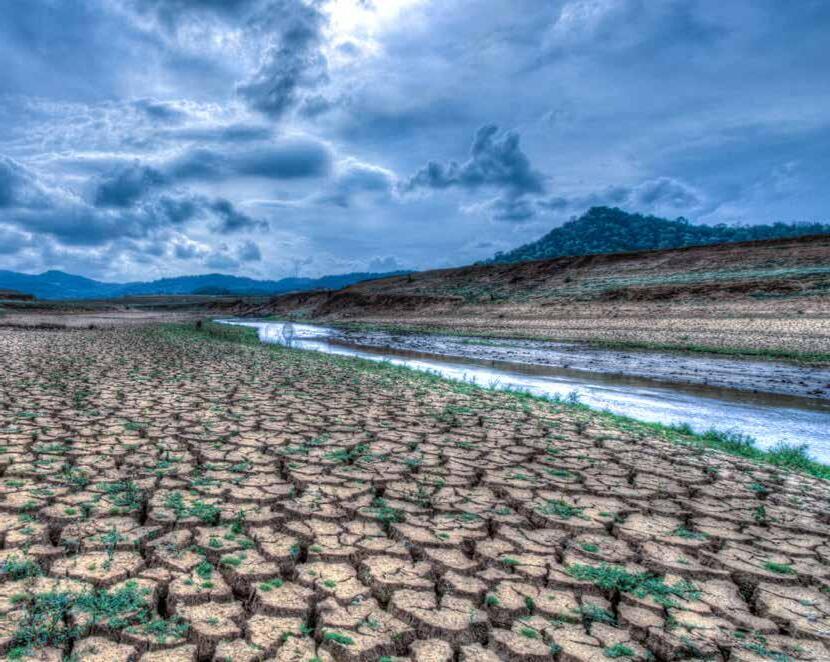
Climate change will bring hydrological changes that challenge the sustainable management of water resources and affect the availability, quality and quantity of water for basic human needs. And the impacts on Africa’s water resources are already acute.
Water use has increased sixfold over the past century and is rising by about 1% a year. However, it is estimated that climate change, along with the increasing frequency and intensity of extreme events – storms, floods and droughts – will aggravate the situation in countries already currently experiencing water stress and generate similar problems in areas that have not been severely affected.
According to the newly released United NationsWorldWaterDevelopment Report2020:WaterandClimateChange , a deterioration of water availability, quality and quantity as a result of climate change will hinder the achievement of Sustainable
Development Goal (SDG) 6, which calls for access to safe drinking water and sanitation for all by 2030. This will be a considerable challenge considering that 2.2 billion people currently do not have access to safely managed drinking water, and 4.2 billion – or 55% of the world's population – are without safely managed sanitation.
According to the report, the impacts of climate variability on Africa’s water resources are already acute, with several studies finding that rainfall in Southern Africa has decreased recently, likely as a result of climate change.
Climate-related impacts are also expected to increasingly interact with non-climaterelated drivers of water scarcity and water pollution, such as a growing population, economic development, and conflict and fragility. On the African continent, where the population is predicted to grow by more than a half billion by 2050, the increasing water stress will be particularly pronounced. The report also states that water-related
impacts of climate change on human health are expected, through vector- and waterborne diseases (including by further challenging access to safe drinking water, sanitation and hygiene) and via malnutrition, given the expected impacts on food security. In agricultural systems, especially in semi-arid areas, conventional livelihood-based approaches do not appear robust enough to deal with the long-term impacts of climate change.
The report indicates that the experience of water-related impacts of climate change in sub-Saharan Africa is exacerbated by policy contexts that suffer from challenges in coordination as well as gaps in monitoring and research.
In the face of these threats, the report highlights the two complementary strategies to be implemented – adaptation and mitigation:
• Adaptation encompasses a combination of natural, technical and technological options, as well as social and institutional measures to mitigate damage and exploit the few positive consequences of climate change. It is likely to have very rapid benefits, mainly at the local level.
• Mitigation consists of the human actions needed to reduce greenhouse gas (GHG) emissions while exploiting carbon sinks to reduce the amount of CO2 and other GHGs in the atmosphere. It can involve large geographical areas, but with gains that may be spread over decades. However, the possibilities
for mitigation in water management remain largely unrecognised.
The authors note that while the need to combat climate change through better management of the water cycle is well recognised, it is not being translated into reality. “The word ‘water’ rarely appears in international climate agreements,” observes Audrey Azoulay, director-general, Unesco.
The ‘nationally determined contributions’ submitted by states under the Paris Agreement remain general in nature, without proposing specific plans for water. While most countries recognise water in their portfolio of actions, few of them have actually calculated the costs of these actions and even fewer have put forward specific projects. Meanwhile, the possibilities for synergies between adaptation and mitigation measures are often neglected.
Wastewater treatment contributes to climate change, as it generates GHGs through the energy it requires and the decomposition of organic matter, accounting for an estimated 3% to 7% of all emissions.
It is estimated that, worldwide, between 80% and 90% of wastewater is discharged into the environment without any form of treatment. Left untreated, wastewater is a major source of methane. Wastewater harbours more energy than is needed for its treatment, provided that it is harnessed. In concrete terms, the optimal management of water resources means investing in modern treatment techniques that allow for the extraction of methane from organic matter to generate the energy needed to run the process. Where these techniques have been successfully implemented, public utilities have reduced emissions by thousands of tonnes of CO2, while making financial savings and improving the quality of the service.
The question of finance is crucial. The authors point out that water resources management and water supply and sanitation services are underfunded and require greater attention from countries. There are increasing opportunities to systematically integrate adaptation and mitigation planning into water-related investments, in order to make them more
attractive to donors. A good example of this is a Green Climate Fund project in Sri Lanka, which aims to improve irrigation systems in vulnerable village communities and promote climate-smart agricultural practices in three river basins, offering both climate adaptation and mitigation benefits, while conserving water and protecting drinking water sources.
Various water and climate change initiatives can also bring co-benefits such as job creation, improved public health, poverty reduction, the promotion of gender equality and improved livelihoods, further enhancing their attractiveness to donors.
The adoption of integrated adaptation and mitigation measures is a win-win proposition. They are clearly beneficial for the sustainable management of water resources and the human right to safe drinking water and sanitation. They also directly address the causes and consequences of climate change, including in terms of the response to extreme weather events. Finally, they contribute to the achievement of several of the SDGs.
“If we are serious about limiting global temperature increases to below 2°C and achieving the SDGs by 2030, we must act immediately. There are solutions for managing water and climate in a more coordinated manner and every sector of society has a role to play. We simply cannot afford to wait,” stresses Gilbert F Houngbo, chair of UNWater and president of the International Fund for Agricultural Development.
Azoulay adds, “Water does not need to be a problem – it can be part of the solution. Water can support efforts to both mitigate and adapt to climate change.”
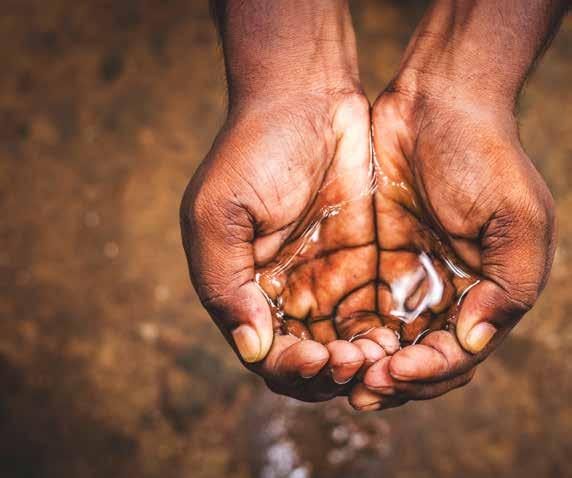

www.unwater.org/publications/


































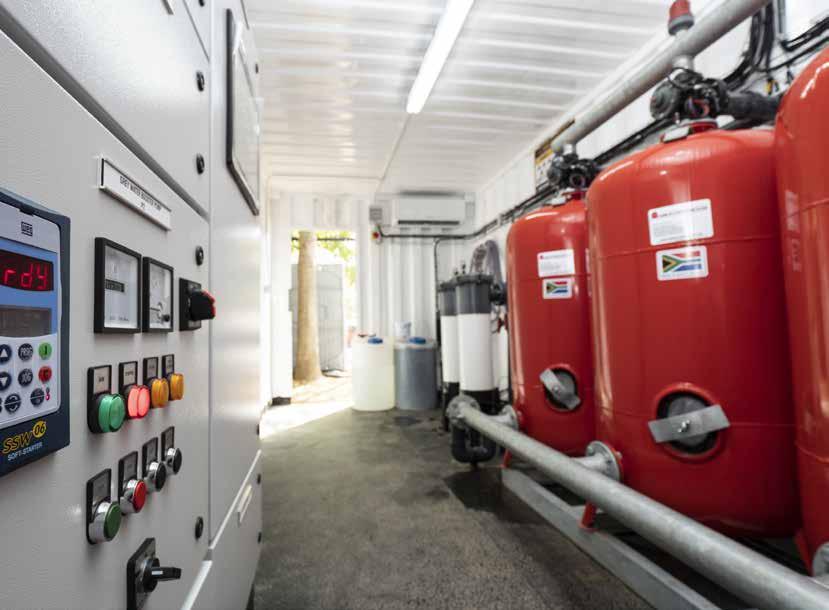
Stellenbosch University’s main campus is now home to one of the largest greywater reuse systems in Africa, as it works to improve campus water supply resilience and reduce dependency on municipal supply.
The system, designed by JG Afrika, comprises two installation phases, one of which is complete. Once both phases are installed, the network is designed to flush over 1 300 toilets used by about 25 000 university students to meet a significant portion of campus water supply and supplement campus irrigation. During term time, up to 75 m3/day of greywater has been treated and reused (Phase 1). This capacity could be increased to between 150 and 200 m3/day after Phase 2.
Benjamin Biggs, a civil engineer in JG Afrika’s Municipal Infrastructure and Sustainability divisions, says that the firm was appointed by SUN to develop a sustainable water-management master plan prior to the severe 2017 Western Cape drought.
“The plan focused on reducing potable demand and increasing campus supply resilience by using all identified water sources optimally and avoiding potable water for irrigation. Water Sensitive (Urban) Design (WSD) principles were used as a framework to achieve sustainable water management on campus. WSD is an internationally accepted approach that addresses limitations of conventional urban water management,” Biggs says. JG Afrika developed a comprehensive SUN water balance by first assessing and modelling eight representative buildings. Water characteristics from each type were extrapolated across campus to other similar buildings and calibrated against utility data.
Interventions focused on the top 40 users, comprising 80% of total water demand. WSD principles were then applied according to JG Afrika’s Water Management Hierarchy, which focuses on first reducing demand before reusing and finally supplementing existing water supplies.
Notably, campus interventions introduced as part of the first ‘reduce’ stage of the Water Management Hierarchy decreased potable water demand by more than 50%. This stage included the
A project to improve water supply resilience at Stellenbosch University (SUN) has become one of the largest greywater reuse systems in Africa.
installation of efficient fittings, addressing leaks and managing system pressures, in addition to SUN programmes to educate staff and students in the efficient use of water.
The next implementation stage proposed in the water master plan involved water reuse. Greywater reuse on campus was identified as a viable alternative supply and JG Afrika was appointed by SUN to design and implement a campus-wide greywater reuse system for toilet flushing and irrigation.
Biggs explains that in this system, shower greywater is isolated from blackwater in selected residences and redirected into a collection system comprising manholes, grit traps, sumps and a pump station and
then distributed to a centralised campus treatment plant.
The treatment plant has been designed to treat, store and distribute up to 100 m³ of greywater a day in the first phase, and its hydraulic capacity can be doubled in the second phase of the project once more residences are incorporated into the network.
Treatment steps include primary sedimentation, aeration, solids removal/ physical filtration and disinfection/ sterilisation by means of hydrogen peroxide dosing. Treated greywater is stored at the treatment plant for daily toilet flushing and excess greywater can be boosted into the existing irrigation network.
Treated greywater is pumped to a header tank with a booster system, which includes a municipal potable supply backup, situated on the roof of a 10-storey residence to pressurise the non-potable network. Currently plumbed directly into toilets at selected buildings, there are plans for this network be expanded to supply and collect from additional campus buildings during the second phase of the project.
Various health risks are associated with greywater reuse systems and, therefore, risk mitigation was an important part of the system. An environmental regulation screening report was compiled assessing relevant legislation, such as the Water Act (No. 36 of 1998), health and safety, local municipal by-laws, as well as National Building
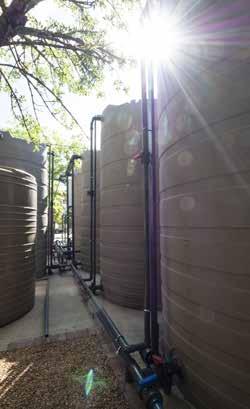
“The plan focused on reducing potable demand and increasing campus supply resilience by using all identified water sources optimally and avoiding potable water for irrigation.”
Regulations, and possible triggers were identified. Furthermore, the risk of cross-contaminating the potable municipal network was mitigated using separate service networks (potable and non-potable); separate plumbing networks (direct non-potable feed to toilets and urinals); and an air gap in the header tank to prevent the possibility of municipal backup supply pushing back into the potable network. Additionally, high-density polyethylene pressure pipes in the ground and internal plumbing pipes are colour coded and, as a final precaution, blue dye is introduced into the treated water to identify future crossconnections should they occur.
The installed system requires ongoing operation and maintenance, as well as the provision of training and technical instruction for SUN staff. This
is needed for system optimisation and to ensure health and safety requirements are met on an on-going basis.
To further build future water resilience, JG Afrika is investigating the possibility of rainwater and stormwater harvesting used in conjunction with sustainable drainage systems to manage aquifer recharge to further augment the system across the campus.
According to Biggs, coordinating such a diverse project team, comprising plumbers, wastewater treatment specialists, civil, electrical, electronic and mechanical contractors, subcontractors and consultants as well as working within active residences proved a challenge. Working in an operational university campus, ongoing communication between all affected parties, including SUN’s facilities management team, staff and students, has also been critical. Therefore, SUN’s project management has played an important role in the project. Notably, the system was the Water Category winner at the 2019 South African Institution of Civil Engineering (SAICE) Western Cape Regional Awards. Biggs has lauded SUN for its continued focus on reducing its water footprint, which is just one of several of the university’s ‘greening’ sustainability initiatives.
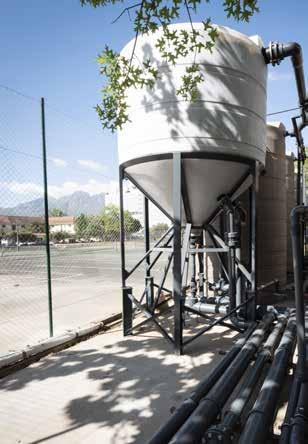
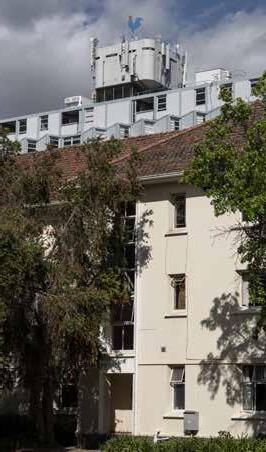
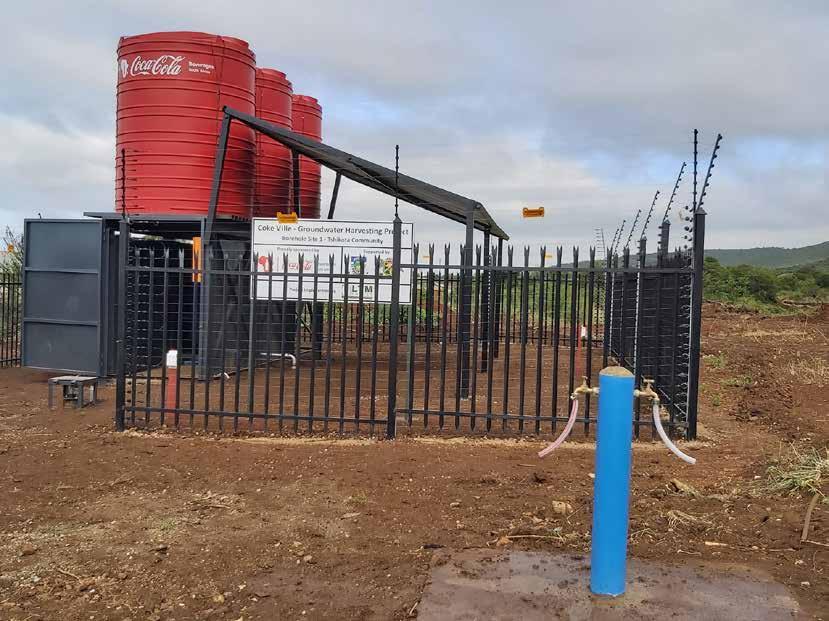
The Tshikota village community in Limpopo has received an off-grid, solarpowered groundwater harvesting and treatment system to boost their water supply.
The project, launched by Coca-Cola Beverages South Africa (CCBSA) and known as ‘Coke Ville’, comprises three boreholes, which will provide the Tshikota village community with a maximum of 157 200 litres of water per day, equating to a maximum of 57 378 000 litres of water per year. The combined systems have the potential to provide water for at least 2 000 households.
Water shortages resulted in community unrest in the Tshikota township, located just outside Louis Trichardt, Limpopo. “As a result, we initiated a groundwater harvesting project in the area, supported by the Makhado Local Municipality, to build three state-of-the-art solar-powered borehole systems,” explains Tsholofelo Mqhayi, head: Enterprise and Community Development, CCBSA.
Globally, more than 660 million people do not have access to clean drinking water. At a more local context, Lepelle Water recently announced that over 100 villages in Limpopo do not have access to clean running water. The current gaps in access to water, sanitation and hygiene pose a great risk to society, businesses and the economy. While government has allocated R3.5 billion to address the water situation in Giyani, also in Limpopo, many communities within the province are still without access to water.
“No organisation can solve the world’s water issues alone, but through innovative partnerships, this vital shared resource can be protected. The most effective work happens when there is collaboration across the public and private spheres for the benefit of the local communities,” says Mqhayi.
Groundwater use has increased by an average of 0.6% per year during the past three years; however, only about 40% (or 3 billion m3/annum)
of available groundwater is used. By supporting the Tshikota township with groundwater, CCBSA is helping to improve community resilience to water-related climate change impacts.
“Through this initiative, we hope to strengthen safe water access and sanitation in humanitarian relief to help communities stay healthy and recover from disasters faster and hopefully inspire people to participate in water protection, access and conservation,” concludes Mqhayi.
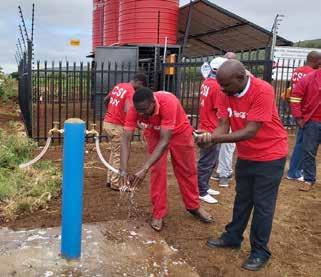
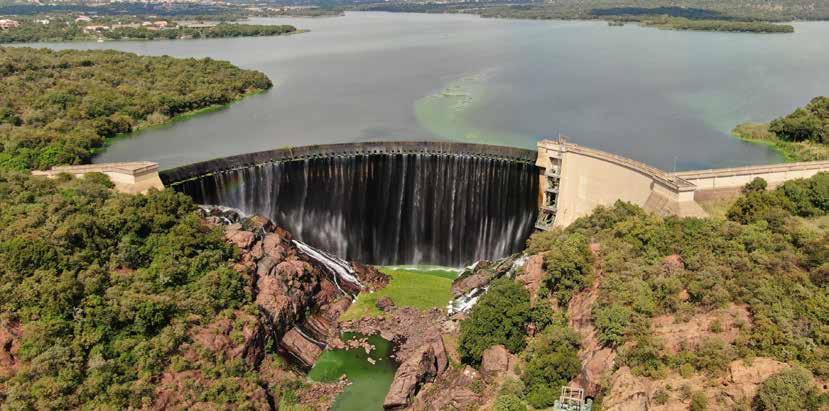
Following treatment, Roodeplaat Dam in Gauteng has seen a marked drop in levels of toxic cyanobacteria.
Roodeplaat Dam has long been faced with deteriorating water quality as a result of cyanobacteria blooms. The cyanobacteria, commonly known as blue-green algae, have been growing exponentially, resulting in the dam becoming hypertrophic and presenting a health threat to both humans and animals.
Now, following the application of BlueGreen Water Technologies’ proprietary algaecide, Lake Guard™ Oxy, water quality tests and satellite images indicate a clear and significant drop in levels of toxic cyanobacteria.
How it works
The floating, time-releasing Lake Guard

particles are naturally propelled by the forces of winds and currents, while selectively eliminating toxic algae blooms in the water, irrespective of size or shape.
The algaecide triggers a selective biological programmed cell death within the general toxic cyanobacteria populations, causing them to collapse. It is based on sodium percarbonate that releases hydrogen peroxide (H2O2) as its active ingredient – an environmental approach that leaves no trace in the water. The Lake Guard products are approved by the USA’s EPA and certified by the NSF/ANSI/CAN-60 standard for treatment in drinking water.
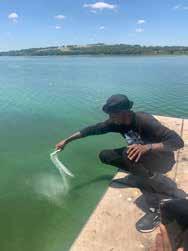

The Roodeplaat Dam treatment is one of several emergency interventions deployed by BlueGreen around the globe.
“The success of BlueGreen’s treatment – around the world, and now in the Roodeplaat Dam – spells renewed hope
for the region. The South African water authorities have taken a brave and necessary first step to improve the quality and availability of water in South Africa and we are proud to take part in this important quest,” says Dr Moshe Harel, founder and CTO, BlueGreen.

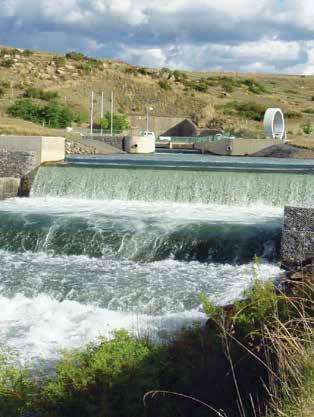

South Africa is a semi-arid region with an average rainfall of 464 mm per year. There is a pressing need to protect our water security, which is expected to worsen as climate change takes effect through longer dry periods usually followed by severe floods.
By Peter Townshend*
South Africa has an approximate design capacity of 33.6 billion m3 of water stored in 575 large reservoirs. This storage is at risk, as demand for water increases and climate change takes its toll, with extended dry periods and floods. Intense rainfall on lands denuded of vegetation – caused by droughts – increases sediment erosion, which considerably reduces dam capacity.
TABLE 1 Large dam capacity lost to siltation
with silt and slowly extend further into the reservoir. This capacity loss is evident in almost all of South Africa’s reservoirs. Figure 2 shows the extensive amount of sediment accumulated at the inlet to the Gariep Dam, South Africa’s largest dam.
Unfortunately, South Africa does not have the potential to build many more dams to increase water supply. Instead, we have to make the most of our existing dams by raising dams to gain additional storage and/or by removing sediment build-up.
Based on the data received from a Department of Water and Sanitation dam report in 2012, 11.5% of our design capacity has already been lost to siltation, using a conservative annual loss of 0.3%. Other estimates of this loss are at 14.6%, with an expectation of 20% within the next 10 years. This is equivalent to an entire large dam’s capacity lost to siltation every year.
As sediment-laden flows enter a reservoir, the sudden drop in velocity allows the heavier particles to drop out on the reservoir floor, as shown in Figure 1. If left unmanaged, the inlet will become clogged
By excavating or dredging an area at the inlet to its original depth and long enough to create an effective sand-trap, solids can be collected and removed in a controlled fashion. The finer sediment is carried into the dam as a density current to accumulate in the deeper waters near the dam wall. This course sediment at the inlet to the reservoir should be removed to win back storage as well as create a sediment trap
for future inflowing sediments. This can be done by:
• Earthmoving equipment: during drought periods, the deposited sediment becomes exposed, which makes removal using conventional earthmoving equipment effective.
• Mechanical dredging making use of excavators on barges to remove solids: it is very effective at extracting solids in restricted areas or where the solids contain mixed materials, reeds and other vegetation.
• Hydraulic dredging: this makes use of water as a medium to transport solids along pipes to a holding dam where the
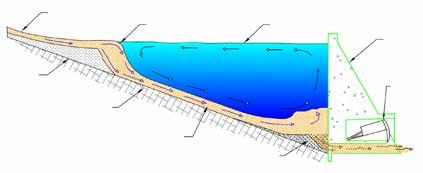
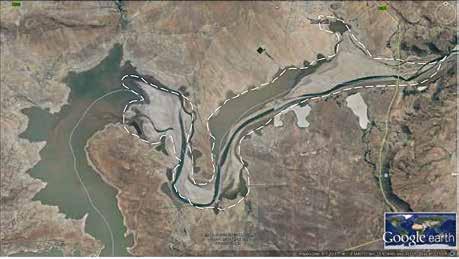
solids are allowed to settle and the water returned to the reservoir.
The best approach
While these measures might be considered costly, with water security in South Africa now a pressing issue, we cannot simply use this as a reason not to act. Raising dams to gain more water using fixed, ungated spillways – which is the current practice –only exacerbates the sediment problem by providing a larger area to fill with sediment, unless measures are taken to remove the sediment at the inlet and create a sediment trap. Ideally, dams should be raised using automatic spillway gates, which are effective and have many benefits over fixed raisings, including sediment removal.
The sediment removed should be used for enterprise development for local communities, which can include:
• sand mining as a commercial enterprise for building materials, including the
necessary transport vehicles, thereby reducing the adverse environmental effects of illegal sand mining from rivers
• brick manufacturing for the building industry
• erosion backfilling and control
• filling over rocky and unusable ground to provide terraces for agriculture
• composting as well as animal fodder using the reeds and vegetation removed with the sediment.
The finer sediment, which is carried in suspension in density currents, should be released through the base of the dam. Unfortunately, most dams in Southern Africa do not provide a large enough outlet to sluice out sediment, leading to an accumulation of fine sediment near the dam wall, thereby reducing capacity. It is, however, possible to retrofit automatic scour gates, as shown in Figure 3.
The scour gate must be able to open automatically during a flood to pass the

sediment-laden current through the dam and then to close automatically to retain the full supply level. In addition to keeping the sediment load in check, it has other important dam safety advantages, such as passing large floods as well as providing a rapid drawdown facility.
Amanziflow Projects’ scour gates can also be opened manually to sluice out sediment in smaller dams by drawing down the water level to flush the dam and then allowing it to refill. This process can then be repeated as a series of flushes. Figure 4 indicates the power available in the discharge from a large automatic scour gate to sluice out sediment. Once a considerable amount of sediment is sluiced out, this type of automatic scour gate will maintain the reservoir relatively free of sediment.
*PeterTownshendisthemanaging directorofAmanziflowProjects.
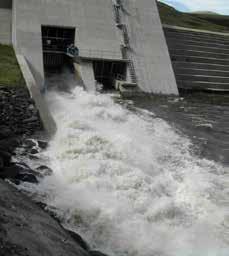
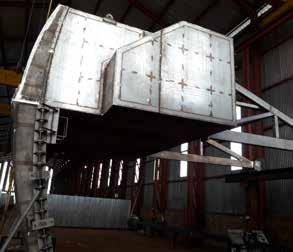
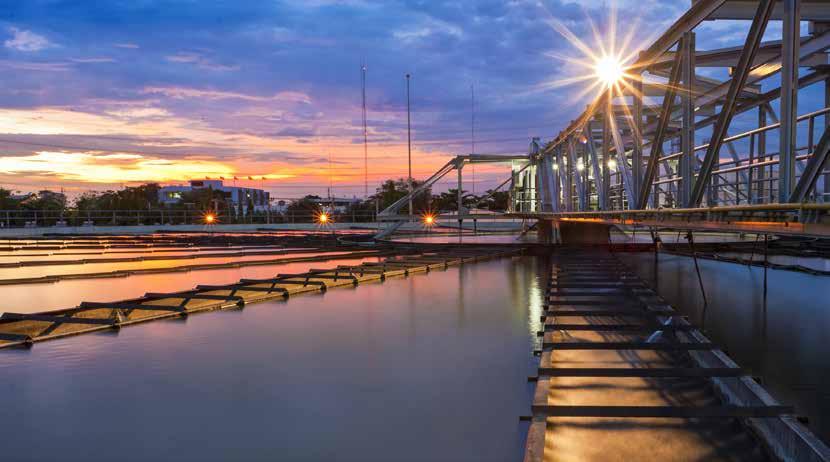
Growing up in the 1970s, I loved reading about the future. Futurists prophesied that technology would solve all our problems within my lifetime. The year 2000 would be the start of a brave new world of abundance.
By Dr Peter Prevos*
The predictions of these futurists have, to a large extent, been fulfilled. The most significant realised foresight of the past is that we now have the sum of all human knowledge at our fingertips through the internet. Technological developments, especially those that rely on digitisation, are progressing at an ever-faster pace and transforming global societies.
Water utilities have always relied on technology, but digitisation is revolutionising – and will continue to change – the way we provide water services. The term ‘digital water utility’ is often used to describe a service provider that fully embraces digital technologies to improve the quality and reliability of water for citizens.
Technology develops at lightning speed and implementing digitisation can be quite complex. Managers responsible for implementing new technology at water utilities can feel like a child in a candy shop. The market for digital solutions provides a cornucopia of enticing technologies to choose from. However, water utilities only have limited resources to review and invest in these solutions.
This article reflects on the concept of the digital water utility and provides
some guidance on how to navigate the complex landscape of technological progress.
Technology and water utilities
Supplying safe drinking water to communities and collecting their sewage is predominantly a technological project. Water engineers apply physical technologies such as water filtration to minimise risk to human health and the natural environment. These technologies are very reliable and have served us well over the past two centuries. As a matter of fact, water utilities are so reliable that Uber wants to be as reliable as a water utility.
The development of digital technology has accelerated over the past two decades.
Three of these developments are driving changes in the way we operate our assets:
1. Almost all processes leave a digital footprint. While we previously relied on paper records, modern assets continuously measure their status, and interactions with customers are also stored in computer systems.
2. Data storage has become exponentially cheaper and computers faster. A simple iPad is as fast as the most fantastic supercomputer from 1985. This increased computer power enables us to analyse problems that used to be out of reach.
3. Developments in computer science and open-source software have provided us with powerful tools to manage and analyse this
data. These new methods, often called data science, offer perspectives on our operations that were previously impossible.
Although we do have an abundance of digital technology to improve society, our problems indeed have not vanished. The technologisation of the world has caused many of the environmental issues we currently face. The ever-increasing impacts of climate change place unprecedented pressures on water utilities. On top of these environmental changes, the expectations of customers are increasing.
President Cyril Ramaphosa recently said, “Unless we take drastic measures to conserve water sources and promote efficient use, water insecurity will become the biggest developmental and economic challenge facing this country.”
These fast developments are encouraging,



but they introduce a risk of failure to meet the business case objectives. How can water managers best decide what technology to use and leverage data science?
data science
One of the rules of strategic data science is that it must be useful. Although analysing data can provide many exciting insights and artful visualisations, not all data or analysis is equally valuable. The purpose of all digital technology is to collect data about the reality that our customers experience. This data is converted into information and knowledge that need to be used to positively influence reality. This feedback loop is often missing from discussions about data. Data and information in isolation will never solve a problem. Only when managers use this knowledge to take physical action can we solve problems. The catalogue of possible data solutions is bewildering. But merely implementing the most recent machine learning algorithm, hoping that it will yield benefits, is the wrong way to think about implementing technology.
influences our water and sewerage systems. But what does it mean to positively impact reality?
The invisible water utility
Water utilities are mostly invisible to their consumers. Our industry delivers services at such a high level of reliability and quality that our customers don't even realise we exist until something goes wrong. Customers are the sentinels of our service because we rely on their feedback to know how they experience the service.
One of the main benefits of being a digital water utility is that we can detect problems before they reach the customer. In effect, digitisation can make a water utility even more reliable and thus invisible to the consumer.
Being an invisible water utility is a somewhat paradoxical situation. While it is the pinnacle of excellent water services, being invisible is not beneficial for the brand of the utility. Digital technology is not only helpful in managing assets. Technology can also help water utilities to connect with their otherwise invisible customers. The single purpose of being a digital water utility is to improve the experience of your customers in the short term and the long run. Enhanced monitoring of assets and advanced analysis of this data can lead to better intelligence of potential water quality issues, overflows in sewer systems, find leaks in networks, detect cracks in pipe inspection footage, connect with customers, and so on.
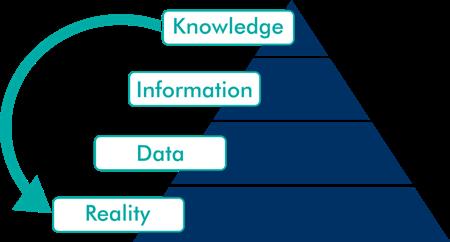
processes and people. Many utilities collect vast amounts of data but fail to maximise its use. Operational processes generate data, but after it is stored, it becomes dark data, waiting to be recycled. The first step in becoming a digital water utility is to understand the flow of data in your organisation.
Once you understand the data, a digital water utility needs to have processes in place to manage and govern this valuable asset. In practice, this means storing all critical information in databases that provide a single source of truth that everybody in the organisation can trust.
A digital water utility conjures images of water utilities run by robots without human intervention. Digitisation does, however, require managers to focus as much on people as on technology. Digital technology is not about replacing people but about providing water professionals with better tools to make the right decisions. Water utility employees and managers need to improve data literacy skills to ensure that new solutions deliver useful outcomes.
Only by building a digital water utility from the bottom up within your organisation will you have solid foundations to reap the benefits of technological developments. The greatest mistake a utility manager can make is procuring technological solutions without the organisational framework to realise the benefit over the long term.
This article briefly described some of the benefits and pitfalls of digitisation. The most important message I would like to leave the reader with is that technology is always about people. Whether it is about the experience of your customers or the competencies of your employees.
Always start with a problem and find the most suitable solution. The most beneficial solution might not always be the most complex one.
We can thus define good data science as actionable intelligence that positively
Becoming a digital water utility requires a strategic approach to implementing technology and understanding data. This strategic approach requires managers to improve not only systems but also
*DrPeterPrevosisawaterengineer andsocialscientist.Heis responsibleformanaging thedatasciencefunction atColibanWaterin regionalAustralia.Prevos alsoteachesdatascience towaterprofessionals throughanonlinecourse. Hehasauthored CustomerExperience Managementfor WaterUtilities(IWA) andPrinciplesof StrategicData Science(Packt).



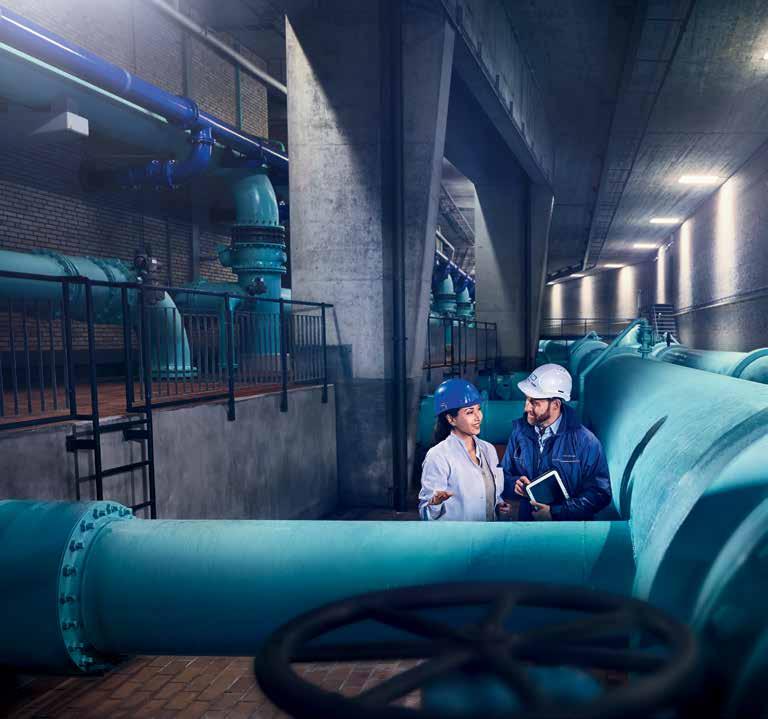
We understand the challenge of finding the right balance between plant e�ciency and compliance with industry standards and legal requirements.














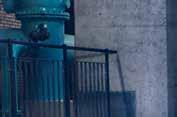


You meet your e�ciency goals and reduce costs without compromising on water quality.
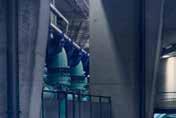


Proline Promag W 0 x DN full bore – The world’s first electromagnetic flowmeter for unrestricted measurements




















• Measure reliably – independent of flow profile and mounting location
• The first and only electromagnetic flowmeter with no inlet and outlet runs (0 x DN) as well as no pipe restriction (full-bore design) and thus no pressure loss
• Installation directly a�er bends, perfect for space-restricted areas and on skids
CONTACT US:
Email: info.za.sc@endress.com
Do you want to learn more? www.za.endress.com/5W4C
Tel: +27 11 262 8000 www.endress.com
The digital portion of the market is growing and proving to be important for the sustainable operation of the global water industry. Even when most markets are showing a downturn amid the turbulent times of a Covid-19 pandemic, recent figures from Global Water Intelligence show positive signs in the digital water market.
Digital forecasts
Figure 1 shows the global spending on digital water solutions by application. Compared with 2019, 2020 and later years show a definite positive increase in the digital market per application, most notably in the water network sector. It would appear that the current market conditions do not affect the forecasts of growth in the digital sector, which is forecast to reach a value of US$47 billion (R860 billion) by the year 2024.
The areas in which QFS operates (customer services, seawater and brackish water desalination, wastewater treatment and process/drinking water treatment) also expect growth within the next five years.
Because it implements various control systems in its plants, QFS will have vast exposure to the increased market forecast as shown in Figure 2. Despite a small slump in 2020, the five-year market forecast bodes well for QFS.
Figure 3 indicates the digital water solutions’ global market share. QFS’s exposure is quite vast, as it operates in the following categories:
• data collection
• water quality sensors
• physical parameter sensors
• acoustic sensors
• conventional meters
• data networks
• communications equipment. From the data shown, the direction in which utility providers, EPC contractors and other water industry sectors across the globe are heading is clear. This is essential proof of how important the implementation of digital infrastructure has become to enable end users to optimise their processes, thereby reducing costs.
South Africa’s digital innovations
QFS continually strives to assist its clients with the latest digital (as well as mechanical) innovations in water and

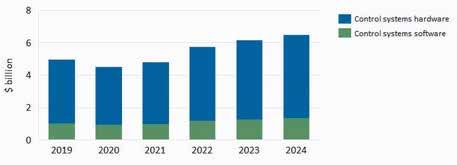
The
extended use of automation systems is crucial to water quality in any water treatment plant in the 21st century.
By Annejan Visser*
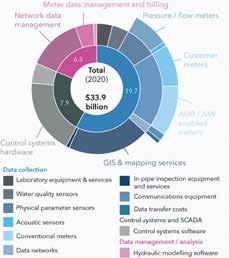
wastewater treatment. Having offered various digital solutions for water and wastewater treatment plants for over 20 years, QFS is well in line with global trends and well positioned in the Fourth Industrial Revolution.
Although many operators see automation as a threat to job security, QFS views automation as a valuable aid to operators. This is because the operator will have access to continued assistance from QFS in the operation of the plant as well as access to valuable data that will help in running their water or wastewater treatment works at optimal levels.
Combined with QFS’s online monitoring ability, operators will be able to build the confidence and knowledge to become part of the implementation of advanced technologies.
*AnnejanVisserisaprocessengineer atQFS.
**FiguressourcedfromWeaver,R.,2020. Theimpactondesalinationanddigital services,Oxford:GlobalWaterIntelligence

Keller recently introduced the ADT1 – a robust level measuring device that sends measurement data via LoRaWAN.
he compact, water-tight stainless-steel housing of the ADT1 contains electronics that are powered by three conventional AA batteries. The batteries provide enough power for five years of operation at a transmission interval of 10 minutes. For non-borehole applications, the ADT-1 Box is available as well.
This model can be used in monitoring pipes/cap locks of two inches or larger and can be suspended at the measuring point without the need for extensive installation work. A PA-26X or 36XW (CTD) level sensor (RS485 interface) or a PA-26D level sensor (I2C interface) can be connected.
in boreholes and tanks.
The ADT1 has an integrated barometer sensor for barometric compensation of the measured values. It also outputs the air temperature and humidity – measured inside the housing – as measured values. The humidity level is an indication of possible leaks in the ADT1, meaning that appropriate actions can be taken at an early stage before the device fails.
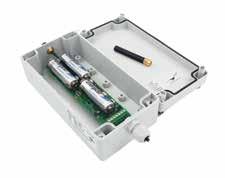
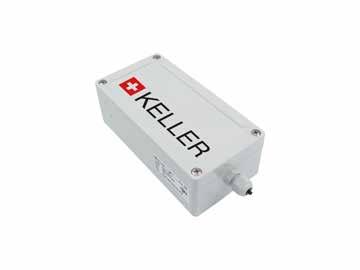
Cable lengths up to 250 m are possible, which makes the system perfect for level measurements
The ADT1 is operated using the cloud measurement solution kolibricloud.com from Keller. Importantly, if you do not have a LoRaWAN network, but do have an internet connection, you create your own local LoRa network with a simple LoRa gateway. Other versions of the ADT1 – with ATEX approval (for use in potentially explosive atmospheres) and with NB-IoT wireless transmission – are currently under development.

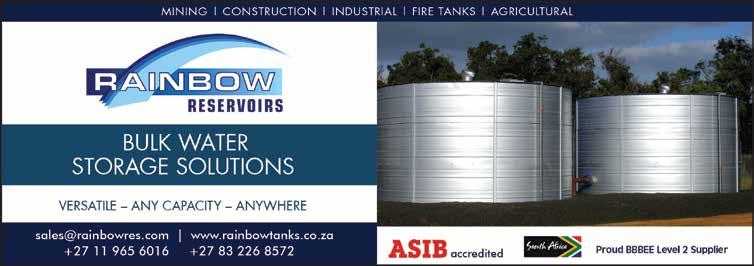

The City of Cape Town joined the Southern African Society for Trenchless Technology (SASTT) in 2006 and has since become one of the country’s leading adopters of trenchless technology.
By Danielle Petterson
The City of Cape Town is responsible for managing almost 9 500 km of sewer pipelines and more than 10 800 km of water pipelines, which need ongoing repairs and maintenance.
Since 2006, the city has made use of numerous trenchless technologies, including pipe cracking, CIPP, pipe jacking, horizontal drilling, and microtunnelling.
And with four fully equipped CCTV vans, Roger Williams, regional operations manager: Reticulation, City of Cape Town, believes that Cape Town is one of the only metros in the country to have its own in-house CCTV crews.
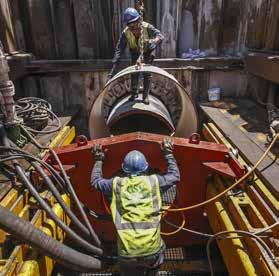
“That is one of the investments the city has made into trenchless technology because we want to go further with new technologies,” says Williams.
With the help of trenchless technologies, the city saw a steady
increase in the number of relaid sewer pipes between 2008 and 2013. Although there was a decline in the following years, Williams reports that the budget has been increased in order to again step up the relaying of pipes. The city has also managed to maintain a relatively low level of sewer spillages linked to pipe conditions.
On the water side, the city saw a similar pattern in the number of relaid pipes, with a steady increase between 2007 and 2011. Repairs to water bursts also increased. Williams notes that the city began to implement pressure management in 2010/11, which played an important role in reducing the number of bursts and addressing the drought crisis.
ABOVE Ductile iron jacking pipes made microtunnelling feasible in the Cape Flats 3 Bulk Sewer Phase 2 project
With the help of trenchless technologies, the city saw a steady increase in the number of relaid sewer pipes between 2008 and 2013
Now, Williams has a particular interest in identifying trenchless technologies to be used in water reticulation rehabilitation projects. To date, the majority of trenchless technology applications in Cape Town have focused on sewer systems. On the water side, the city has mainly focused on pipe cracking. However, Williams says the city is aware of other technologies, such as CIPP being available for water systems, and is always eager to try new approaches.
The City of Cape Town has allocated substantial amounts for water and sewer rehabilitation projects, which will include trenchless applications, and conventional open-cut trenching replacements:
• 2019/20: R120 million
• 2020/21: R165 million
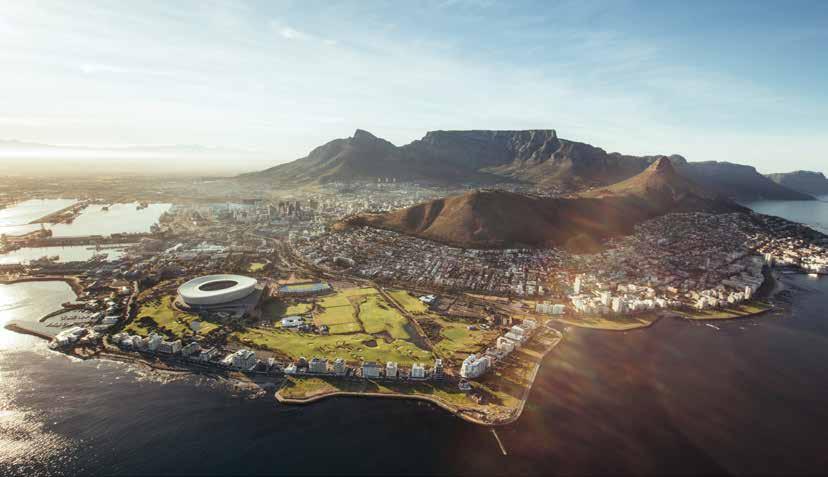

RIGHT In the Cape Flats 3 Bulk Sewer Phase 2 project, 4 m long ductile iron jacking pipes with an outside reinforced concrete sheath were used BELOW RIGHT An unreinforced felt liner was used in the rehabilitation and upgrading of Sanddrift Bulk Sewer
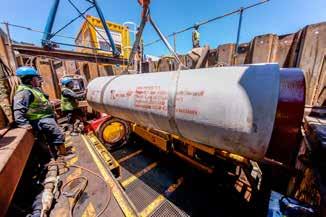
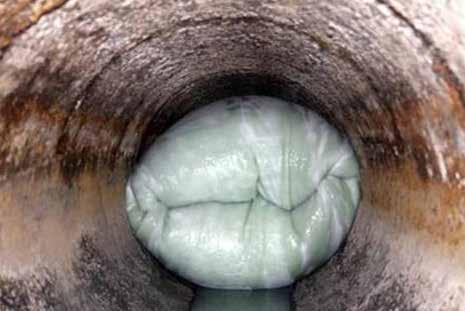
• 2021/22: R165 million.
Williams says that, in recent years, close to half of the budget has been allocated to trenchless applications.
Currently, the City of Cape Town uses term tenders, in which a panel of contractors is appointed for a period of three years. The city has its rates and can re-evaluate and appoint contractors from this panel as and when required. According to Williams, this speeds up the process significantly, allowing for contractors to be appointed within one to two weeks, and having them on-site within a month.
“When you go out on a normal tender, it takes six months to a year to get the tender approved and awarded,” says Williams.
The City of Cape Town’s current tender framework includes:
• 204Q – term tender for trenchless rehabilitation of sewers by pipe cracking (estimated at R30 million)
• 62Q – term tender for trenchless rehabilitation of sewers by cured-inplace lining (estimated at R50 million)
• 64Q – term tender for trenchless rehabilitation of water mains by pipe cracking (estimated at R40 million)
• 176Q – rehabilitation of Cape Flats 1 and 2 bulk sewers (estimated at R300 million).
These tenders are now all compiled
in-house without the need for external consultants. “We started with our term tenders in 2011 and it has worked for the city,” says Williams. Cape Town has even had teams from other municipalities visit to learn more about how the term tender process works and how others can implement it.
Cape Town has also issued several stand-alone tenders for trenchless rehabilitation projects in recent years.
The City of Cape Town’s strong trenchless record is evident in its long list of award-winning projects. Projects that have been awarded SASTT’s Joop Van Wamelen Award for Technical Excellence include:
• 2018 – Rehabilitation and Upgrading of Sanddrift Bulk Sewer
• 2016 – Cape Flats 3 Bulk Sewer
• 2014 – Rehabilitation of Egg-shaped Langa Interceptor Sewer
• 2011 – Irrigation Water Pipeline for Green Point Common
• 2010 – Plumstead Rehabilitation Project. Williams is currently project-managing a large sewer rehabilitation project with an estimated value of R350 million, which will make use of various trenchless technologies. “I think this project will definitely be nominated for an award,” he says. Tenders for the project will go out later this year.
In order to build up sustainable underground infrastructure with minimal disruption on the surface, trenchless methods have been developed and improved across the globe for more than 30 years. By Swen
Weiner*
Generally, trenchless technology is used whenever conditions on the surface are restricted or when ecological and economic reasons require an environmentally friendly installation method. For passing beneath obstacles such as railway tracks, roads and waterways, it is often the only choice.
The advantages of trenchless technology are manifold. Municipalities realise direct cost savings by leaving existing roads undamaged and reduce the need for excavation and back-filling. Tunnelling also avoids lowering the groundwater table and delays due to geological conditions. It is more reliable in terms of schedule and budget, and indirect cost savings include: no interruption on surface, reduced maintenance due to high-quality tunnelling, and reduced emissions and noise (see Figure 1).

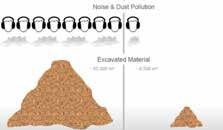

Innovative concepts in process and machinery and continuous further development enable very flexible planning in microtunnel alignments, enabling longer drives, tighter curve radii,
higher groundwater pressures and more challenging geological conditions.
Long-distance pipe-jacking In pipe-jacked microtunnelling, powerful hydraulic jacks are used to push the jacking pipes through the ground. At the same time, excavation at the tunnel face is taking place within a steerable shield. The remotecontrolled microtunnelling machines are operated from a control panel in a container, which is located on the surface. This offers safety advantages because no staff are required to work in the tunnel during construction. The position of the remote-controlled machine is supervised by a guidance system.

A decade ago, the typical maximum drive lengths with larger microtunnelling machines (> DN 1 500) was in a range of 600 m to 800 m. Today, the developed tunnelling technique allow drives of 1 200 m to 1 400 m and longer, even in difficult ground conditions.
The global pipe-jacking distance record was set in 1994 on the Europipe project in Germany, where a tunnel length of 2.5 km was achieved (OD 3 800). In a smaller diameter of OD 3 200, a new record was set in 2018 in Mexico, where a 2 246 m long pipeline casing outfall tunnel was installed.
Appropriate lubrication technology is a key factor in the successful execution of long drives. Continuous lubrication with a bentonite suspension is essential to decrease rising friction forces between the surrounding ground and the pipe string.
The lubricant is squeezed into the annular gap between the pipeline and the surrounding ground through injection nozzles within the jacking pipes. A new generation of Herrenknecht’s bentonite lubrication system enables the optimally adjusted automatic distribution of bentonite suspensions along the alignment by controlling the injected bentonite volumes along each pipe at the same time.
It enables the user to select and adjust the desired bentonite volume of each meter along the tunnel route, also considering changes in geology (see Figure 3). The monitoring, control and recording of relevant data are done in the control container, where the machine operator supervises the pipe-jacking process (see Figure 4).


Another, mostly additional, method of handling jacking forces in difficult ground or long drive lengths is the use

of intermediate jacking stations. The interjacking stations are installed in steel pipes (see Figure 5) at predetermined distances along the pipeline and serve to separately advance the pipeline in sections. This prevents extremely high jacking forces at the rear pipes.
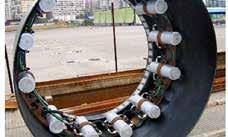

In the construction of utility infrastructure in coastal areas or in river regions, trenchless outfalls, intakes and landfalls are an effective and sustainable method.
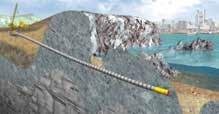
When a sea outfall tunnel is built using pipe-jacking technology, the machine is installed in a launch shaft on the landside and is then pushed through the ground to a target point on the seabed. Tunnelling machines to be used for sea outfalls are equipped with an additional recovery module, consisting of a steel can with bulkhead to close the machine and hydraulic cylinders to separate tunnel and machine.
The supply of hydraulic oil for these cylinders is done by divers and connected from the outside skin of the recovery module. After complete installation of the tunnel, the seaside end of the pipeline is
mostly closed with a bulkhead equipped with a valve.
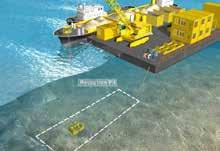
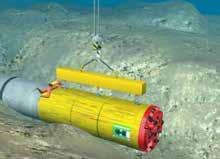
Retractable tunnelling machines are used when the pipe-jacking machine cannot be recovered in the reception shaft or by subsea recovery and is instead pulled back to the launch shaft. This pullback is not reversible – once the machine is retracted, it cannot be brought back to its initial position.
For retraction, the tunnel-boring machine shield is designed with a double skin, where the inner shield is connected to the outer one by means of couplings. The cutter head can either be folded up or it consists of an outer and an inner cutting ring. In the last case, the outer cutting ring stays in the ground together with the outer skin of the machine shield.
Prior to pulling back the machine, the supply lines will have to be disconnected from the machine and pulled back separately through the tunnel. During a second stage, the cutter head will either be folded up or separated from its outer ring. The inner shield of the machine will be disconnected from the outer shield and the machine will be pulled back by the adapted jacking frame.
In most cases, the tunnelling equipment has to be recovered and lifted up to the surface. The jacking machine is equipped with lifting eyes on its upper side for this purpose. There are two ways to lift the tunnelling machine:
1. A barge with a crane is moored at the position from which the jacking machine shall be recovered. Alternatively, a jackup platform with crane – which can lift higher weights than a floating barge –can be installed. The crane is connected by divers to the lifting eyes of the jacking machine by means of a spreader beam.
2. The machine is lifted from the seabed using airbags. These are fixed by divers to the lifting eyes of the machine. A compressor installed on a ship or barge on the surface inflates the number of airbags needed to lift the weight of the machine. Water-level fluctuations caused by ebb and flow may be considered to reduce the lifting height.




The technical standard of modern microtunnelling machines enables curved and inclined tunnel alignments. The length of the machine sections and pipes is a decisive factor for the curve radius. The smaller the radius, the shorter the machine sections and pipes. A stable geology will help to maintain precise steering of the machine, which is essential where there is a constant
gradient of gravity lines – e.g. sewerage tunnels. Jacking uphill with high slope requires adaptations to maintain a functioning supply of the machine components, such as the hydraulic fluids. Higher pump capacities are also needed to overcome the height difference between the launch point and machine position.
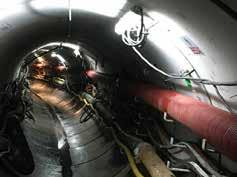
The general approach to connect two underground structures by a cross passage is not new. The technical approach is very similar to standard pipe-jacking, where two shafts serve as launch and reception structures for the tunnelling equipment. Figure 14 gives an overview of different cross-passage concepts.
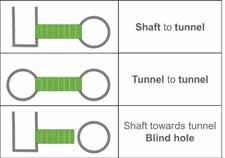
Currently, the most common application field for cross passages is the link of a shaft and tunnel. For a mechanised approach, pipe-jacking can be considered as the preferred technology, also assuring construction safety and installing the final lining. In this case, a tunnel-boring machine starts excavation in the shaft and then breaks through in the tunnel, where it is dismantled and transported back to the surface.
In some cases, the tunnel must remain unaffected by the construction of the cross passage. Here, a mechanised solution using a retractable machine allows for the construction of a cross passage without interrupting the traffic in the tunnel.
For mechanised cross-passage construction, different machine concepts and lining methods can be considered according to the geology and
groundwater conditions. In unstable ground with groundwater, pipe-jacking is the chosen lining process. Only in dry and stable conditions can conventional lining be considered a real alternative.
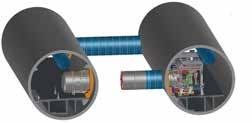
Almost all tunnelling projects require shafts, either as start and reception shafts for the tunnelling process or for inspection, ventilation and rescue purposes (see Figure 16). The Vertical Shaft Sinking Machine (VSM) was originally developed by Herrenknecht for the mechanised construction of deep-launch and reception shafts for microtunnelling.
The machine concept, fully remote-controlled from the surface, as well as its implementation on-site proved to be an efficient solution for the safe and fast creation of shafts, especially in difficult, inner-city environments, without lowering the groundwater table. To date, some 83 shafts have been successfully installed worldwide with the Herrenknecht VSM technology, reaching depths of up to 115 m.

The boundaries of microtunnelling have been shifted continuously over the years and the development of new and existing technologies and features has opened new possibilities. Encouragingly, public interest in trenchless technologies is growing. Nevertheless, the acceptance and level of utilisation of trenchless solutions strongly depend on the region or country under consideration.
Milestone projects such as the Kpone Independent Power Project in Tema, Ghana – where an AVND 2000 tunnelling machine installed a total of four drives with lengths of up to 1 100 m in difficult rock conditions – make the public aware of what can be achieved with trenchless technology.
*SwenWeinerisareasalesexecutive:MiddleEast& AfricaatHerrenknechtAG.






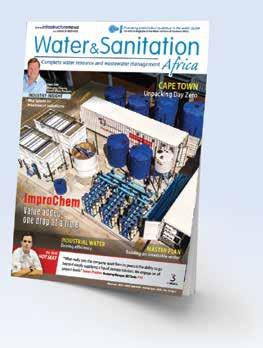




In this age of rapid urbanisation and population growth, Africa is facing a sanitation crisis.
By Serigne Mbaye
Thiam*
For many years, our continent has been unprepared and ill-equipped to provide the sanitation infrastructure our populations need, and demand for such infrastructure continues to rise faster than we can supply it. Africa therefore has a lot to achieve by 2030, to meet Sustainable Development Goal (SDG) 6, which seeks to ensure the availability and sustainable management of water and sanitation for all.
Positive steps
Ministers across Africa consequently have a critical role to play. In 2016, we took an important step towards this goal, when ministers convened in Senegal to sign the Ngor Declaration. We made important commitments to achieve universal access to adequate and sustainable sanitation and hygiene services and eliminate open defecation by 2030. In the last decade alone, over 650 000 people across the continent
for ministers to embed much-needed infrastructure, enhance the health of our communities and guarantee dignity for all.
That’s why I support the African Ministers’ Council on Water’s Africa Sanitation Policy Guidelines (ASPG) initiative. The ASPG has been designed to provide a foundation for countries to adapt, in order to develop sustainable and inclusive sanitation policies that are tailored to each country’s needs. Senegal has long committed to improve access to sanitation, and its sanitation sector is today among the most developed in sub-Saharan Africa. The adoption of new reforms and approaches has enabled the Senegalese sanitation sector to grow at a sustained pace, yet our country still faces challenges.
Access to basic sanitation in rural areas still falls behind, with only 42.3% of our rural population having access to basic sanitation in 2017, compared to 67.4% in
This is precisely where the ASPG brings value. Not only does it focus on providing guidelines for the creation of policies that can support sanitation in rural and urban areas in the present, but it also focuses on the sustainability of such policies. After all, what good is something if it only benefits the current generation? We must look to those who will be moving our country forward when we are no longer here.
Comprehensive and inclusive sanitation policies will provide an opportunity for us all to enhance the provision, reliability, and security of the water and sanitation sector. Next year, Senegal will be the first sub-Saharan country to host the World Water Forum, demonstrating the remarkable progress taking place in Africa. Moving forward, I hope to further build on this progress in collaboration with fellow African ministers.
By utilising resources such as the ASPG, countries can quickly and effectively implement policies that work for their respective regions – policies that are built to last. As Africa’s sanitation leaders, we ministers in charge of water and sanitation are largely accountable for SDG 6, so I urge my peers to join me in accelerating this progress and transforming our continent and the lives of our citizens for good.
*SerigneMbayeThiamisSenegal’sMinister
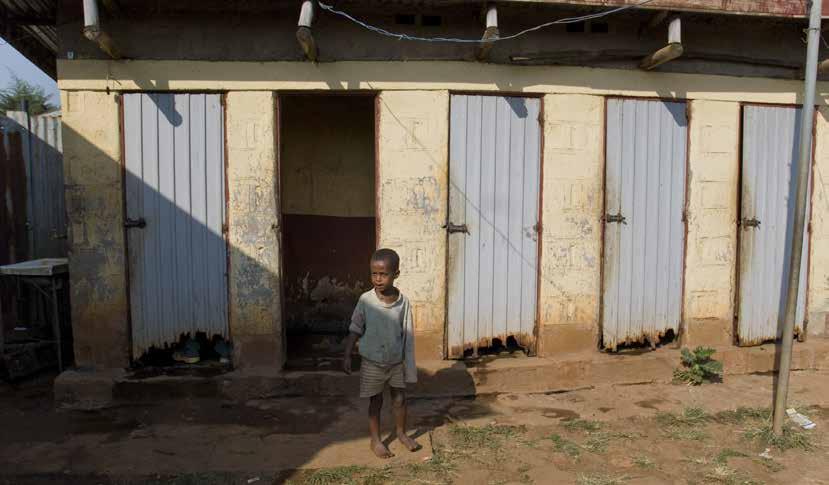
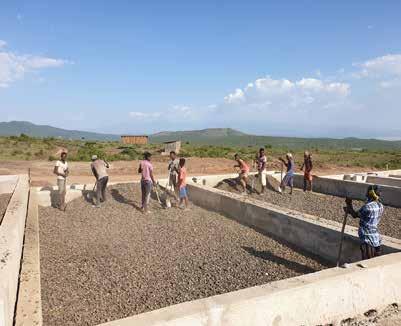
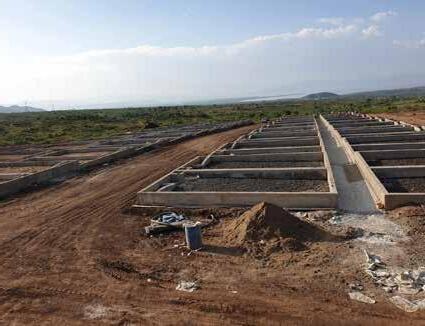
Located along the Great Rift Valley, Arba Minch was founded in the early 1960s. All households and institutions in the town use septic tanks in the absence of an integrated sewerage system.
These tanks are emptied on average once a year and the contents were being discharged directly into a small tributary of the Kulfo River, which drains into Lake Abaya. This practice not only affected the stream but also placed the groundwater wells at risk, contaminating the town’s water supplies as well as those of local fruit farms.
The town’s solid waste is collected by private individuals contracted to the municipality who use donkey carts. The private operators transport the solid waste to a site out of town, where it is roughly separated into glass, paper and plastic for recycling.
Bolstered by funding from the African Development Bank, the Arba Minch Municipality awarded a bid for the design and implementation of a more effective system to global engineering consultancy firm SMEC. The SMEC project team decided to take a holistic approach to the problems of sanitation and solid waste disposal by designing a system
that would be inexpensive to implement and easy to manage. Additionally, SMEC wanted the process to build capacity for municipal staff and local service providers.
Sanitation solution
SMEC’s solution for treating the sewage sludge is similar to the approach adopted by Ancient Greek communities who drained sewage from their settlements away from the water source to a collection basin (cess pit), from where it was drained to agricultural fields to water crops and fertilise soils. Sunlight (UV rays) played an important part in killing bacteria.
Taking that same principle and adding a few modern touches, SMEC designed and set up an easy-to-manage system to deal with the effluent from the town’s septic tanks and separate solid particles from the liquid waste, which is then converted to an organic fertiliser.
The liquid sludge from septic tanks can now be taken to a site of approximately 2 ha, several kilometres outside Arba Minch.
The sludge is spread over a large sand base and the liquid is drained to a treatment pond, effectively
separating liquid and solids. Here, a natural biological process neutralises the bacteria and the resulting treated effluent can drain into the local stream, located upstream of the town’s main water source.
The solid waste left behind is dried in the sun, where the natural biological processes and UV rays take care of remaining pathogens. The dried cakes are turned on a weekly basis; after 20 to 40 days, they can then be safely handled, bagged and sold to local farmers. This source of natural fertiliser is already in great demand from banana and other fruit farmers.
Solid waste management
Solid waste management from households is also receiving an updated plan that will see more people being employed in the separation and recycling of waste. A small composting industry involving the collection of waste from gardens and kitchens and converting it into organic compost is already being effectively run by a few families from the town.
Multipronged approach
For these projects to remain

viable and effective, SMEC adopted a multipronged approach that included the buy-in of local inhabitants. A marketing campaign was created to raise awareness of themunicipality’s goals and to secure public involvement in the plans.
“The project philosophy adopted by the SMEC team was to find solutions that suit the local inhabitants and the environments in which they work,” says Nicholas Rowse, functional manager: Water Supply, Sanitation and Drainage at SMEC.
“The project implementation involved the use of two local emerging contractors as well as local material and labour. As part of our team, we coopted the services of a professor at the Arba Minch University who assisted us in the training of municipal staff and who will be engaged to assist in keeping the projects running successfully on a long-term basis,” adds Rowse.
The projects should be fully completed by the end of May 2020. The Arba Minch Municipality has reported that the World Bank is looking to use the same model as a blueprint for similar projects in other secondary Ethiopian towns.
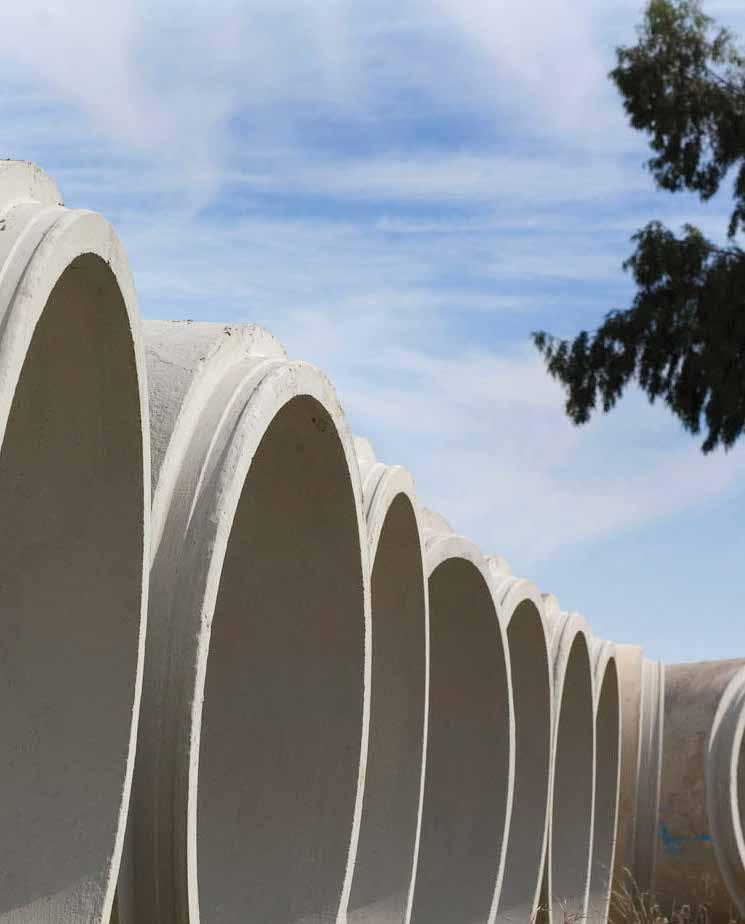
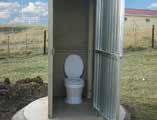
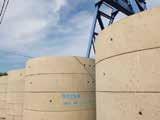
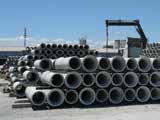

ROCLA is South Africa’s leading manufacturer of pre-cast concrete products.

Surpassing 100 years of product excellence.
• Pipes
• Culverts
• Manholes
• Poles
• Retaining walls
• Roadside furniture


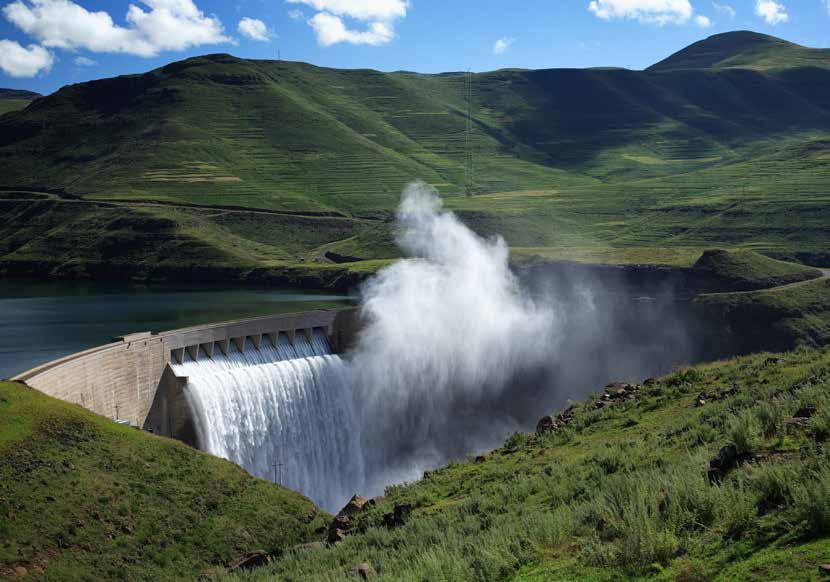
A new report released by the Water Integrity Network and Corruption Watch has highlighted widespread corruption in South Africa’s water sector.
The report, authored by Mike Muller and titled Moneydown theDrain:corruptioninSouth
Africa’s water sector, states that South Africa’s significant water challenges are aggravated by corruption, whose impact can be measured in dry taps, lost jobs, polluted rivers and those who have fallen ill as a result of unsafe drinking water and inadequate sanitation.
“Corruption in the water sector has resulted in deaths,” the report dramatically claims, which highlights problems such as bribes, irregular awarding of tenders, poor quality work and collusion.
“Corruption in the water sector is systemic; the formal rules have been superseded by informal rules that bypass or distort formal processes. The solution to this is not simply strengthening the formal rules. If the underlying driver is political – for example, securing political party funding or securing political power – which appears to be the case in some instances, strategies to address it must be different from where the main driver is personal financial gain,” states the report.
To this end, it identifies several corruption strategies, including:
• manipulation of procurement and operational processes
• influencing policy and regulatory decisions
• taking control of the decision-making sites of key institutions.
The report claims that corruption in the water sector is systemic, involving people from the lowest to highest levels, with many private businesses benefiting richly. Examples range from corruption in the supply of water by road tankers and the provision of temporary toilets, to the systematic looting of large-scale construction contracts intended to develop water resources and ensure water security for the country.
A finger is pointed at former Minister of Water and Sanitation Nomvula Mokonyane, as corruption appears to have blossomed during her tenure from 2014 to 2018. Although corruption was already a problem in the Department of Water and Sanitation (DWS) prior to Mokonyane’s tenure, it had been at a smaller scale, with the Special Investigating Unit (SIU) reporting 28 criminal cases
involving R50 million. However, by the time Mokonyane left, irregular expenditure was well over R4 billion, with new cases still being uncovered and the DWS effectively bankrupt.
One of the projects highlighted is the much-publicised Giyani Water Project. The Auditor General’s office told Parliament that there had been R2.2 billion in irregular expenditure on the project because contracts had been awarded irregularly. Furthermore, the DWS said that it would cost R10 billion to complete the project and bring water to all the people in this small town and its more than 90 surrounding villages.
Another project that has received media attention is the long-overdue Lesotho Highlands Water Project (LHWP), which supplies water to the Gauteng region and generates hydro-electricity for Lesotho. The report argues that, in the 1990s, the first phase of the project provided a textbook case of corruption in large public sector construction projects.
One consequence of the corruption in Phase 1A of the LHWP is that substantial efforts were made to avoid further corruption in Phase 2 – the construction
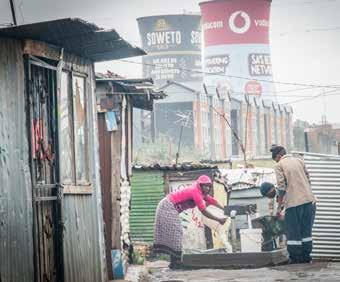
of the Polihali Dam. However, the report explains that, as the minister responsible from the South African side, Mokonyane actively sought to change the procurement requirements for the project. These arrangements had been established bilaterally by the two governments, in consultation with the World Bank and other potential funding agencies.
Mokonyane’s first move was to replace the leader of South Africa’s delegation on the project with her own nominee. She publicly stated that her aim was to ensure that the work would not go to “the usual companies”, despite the design and supervision of the project being highly complex. At the same time, she is alleged to have worked with directors of consulting company LTE to find ways to change the project specifications, to enable them to participate in the redesign of the project.
Ultimately, Mokonyane is accused of further delaying an already delayed project, placing the region served by the Vaal system and Lesotho’s dams at risk of serious supply restrictions if there were to be a drought before 2026.
Another failed project during Mokonyane’s tenure, the War on Leaks, saw more than R3 billion spent on training 10 000 artisans and ‘water agents’ between 2015 to 2019 in a bid to reduce water losses. Unfortunately, the project did not reduce water losses or create jobs.
The report claims that, as with the Giyani Water Project, Mokonyane distributed DWS funds to other agencies, bypassing financial management controls. With billions in funding given to various role players to implement training, it emerged that the municipalities where the trainees were supposed to find jobs had not been consulted. It was difficult even to place trainees for the practical experience that they needed to graduate.
Eventually, the programme collapsed, and the Auditor General found that it
had not been budgeted for and that money was being diverted, illegally, from other DWS programmes. The DWS could not pay the trainees and most of the trainees graduated with qualifications that are not formally recognised.
The report also points to the Blue, Green and No Drop reports, which have not been published since 2014 after meeting political resistance when they shone a spotlight on municipalities that were not complying with regulations.
The report details numerous other projects and incidents, some major, which have been clouded by corruption, including: the proposed Umgeni Water and Mhlathuze Water merger, the raising of Clanwilliam Dam, the Gariep pipeline, the provision of chemical toilets in Ekurhuleni, and Nelson Mandela Bay’s desalination project.
According to the report, these cases suggest that “corruption is now endemic, present and taken for granted, across the South African water sector. It’s simply regarded as what may be needed to get work done. And it is not limited to the public sector.”
- educate the private sector - support civil society.
The report emphasises that, although many of the worst cases of corruption have been well publicised, those responsible appear to have enjoyed impunity because of their political status. This is taken as a licence for corruption at lower levels, as it spreads throughout the organisation. While ending corruption will not solve all the country’s water problems, those responsible for appointments to positions in the water management system –including the appointment of the minister – should be seen to be making a particular effort to ensure that only people of unimpeachable integrity are put in charge of this vulnerable, life-giving resource.
The report argues: “Water is too important to allow its management to be undermined. Because of corruption, fewer people have reliable water supplies and many, particularly young children, old people, and those with compromised

immune systems became ill as a result of drinking unsafe water or because their parents could not keep their homes and toilets clean and hygienic. It is safe to say that corruption in the water sector in South Africa has resulted in deaths.”
The report makes several recommendations to help address corruption in the water sector, namely: 1. Designate the water sector as an ‘island of integrity’
2. End impunity and instil a culture of consequences
3. Appoint honest and ethical people to build honest institutions
4. Improve procurement
5. Ensure transparency in regulatory decisions
6. Address environmental factors, including: - preferential procurement - regulation of political parties
ACCESS THE FULL REPORT HERE:


Programmatic approach
Among the new financial instruments and products it develops, the DBSA is currently working to design programmes that can address specific challenges that South Africa faces. Many of these seek to address the country’s water and sanitation difficulties.
The bank follows an integrated approach to infrastructure development for both public and private sector clients. According to Johann Lübbe, product development specialist, DBSA, building on the success of the Renewable Energy Independent Power Producer Procurement Programme, the integrated approach lies in a centralised ‘centre of excellence’ to drive preparation, facilitate funding and monitor implementation, as well as developing customised blended funding solutions.

This centralised ‘centre of excellence’ takes the form of a programme management office that manages all aspects of project preparation, funding and implementation, including:
- creating an enabling environment
- project preparation
- procurement
- standardisation
- best practice
- communication
- technology and innovation
- monitoring, reporting and contract management.
“Let’s take water reuse as an example. You’ll have a national office where you can centralise all water reuse expertise and approaches, including the standardisation of procurement, funding and implementation documentation. This will prevent us from having to ‘reinvent the wheel’ every time we prepare and implement a water reuse project. This office will become a dedicated centre of excellence that will manage a set of waterrelated programmes,” says Lübbe.
“We often find that every second project has different terms of reference or contracting documents. There is a lot of opportunity and benefit in standardising the approach and documentation.”
The DBSA seeks to design blended finance solutions for the different programmes in order to crowd in private sector investment into infrastructure delivery at scale.
“With this blended finance approach, we want development finance
The Development Bank of Southern Africa (DBSA) is developing a set of infrastructure programmes with a major emphasis on water, as it seeks to address some of the country’s infrastructure, water security and service delivery challenges.
institutions (DFIs) to play a specific role of credit enhancement to crowd in the private sector using their capital market instruments or whatever is appropriate for that specific infrastructure asset class.
“The DFIs then provide credit enhancement because that lowers the risk for commercial and institutional investors and makes financing more attractive. If you lower the risk, your overall blended rate and cost of financing can be reduced,” explains Lübbe.

The programmatic design approach and principles include the following:
1. National programmes
Initiatives to be developed and established as national programmes in support of priority government plans and interventions such as the District Development Model and the National Water and Sanitation Master Plan.
2. Priority/pilot projects
Identify, prepare and implement priority/ pilot projects in parallel to establishing the programmes.
3. Infrastructure Fund
Initiatives are being positioned as programmes under the Infrastructure Fund project pipeline.
4. Innovative and alternative technical solutions
Consider innovative and alternative technology that is often more costeffective and more appropriate than conventional technology and service delivery mechanisms.
5. Private sector participation
All programmes designed to facilitate private sector participation, both from a funding and implementation perspective.
6. Operation and maintenance
All programmes are being designed to specifically address operations and maintenance, which are often neglected in the design and implementation of infrastructure solutions.
According to Lübbe, a major focus is on designing fit-for-purpose, innovative solutions that provide a good level of service while enabling private sector participation.
Among the priority programmes being developed by DBSA are the following:
1. Water Reuse Programme
This is a programme and funding solution that will allow for municipalities to scale their water reuse projects and enable the creation of water reuse infrastructure as a new asset class. This will facilitate the creation of a ‘new’ source of water
to address water deficit challenges and mitigate the impacts of climate change.
The DBSA, as an Accredited Entity to the Green Climate Fund (GCF), has successfully secured project preparation funding from the GCF for the design of the Water Reuse Programme. The intention is also to approach the GCF for concessional funding that will be used in a blended nature for water reuse projects in the country.
The programme will target metros and intermediate cities. There is an opportunity for the City of uMhlathuze’s reuse PPP project to be the first funded by a water reuse project bond blended finance solution.
Discussions are currently under way with various government role players to establish a National Water Reuse Programme.
2. Non-revenue Water Programme
This is a water conservation and demand management programme focusing on reducing losses and over-consumption, as well as improving cost recovery. The establishment of a National Nonrevenue Water Programme has been conceptualised and various projects are being considered for preparation and to be implemented parallel to the design of the programme.
3. Private Sector Participation Model
This is an interventionist model to allow for private sector participation (PSP) in the provision of municipal water and sanitation services.
The PSP Model aims to make use of private sector skills and expertise in the provision of services, and access private sector funding for such projects. This will alleviate strain on many under-resourced municipalities struggling with the provision of water and sanitation services and where very little own revenue generation potential exists.
A position paper was prepared between various government departments and the private sector, and an agreement was reached on key principles of the PSP Model to be tested on pilot projects. A shortlist of 17 potential pilot municipalities has been formulated. The team is preparing to meet with provinces and shortlisted municipalities, after which three to five pilot projects will be selected where projects meet the PSP Model criteria and are ready for investment.
Other, non-priority programmes under development include:
1. Community/rural water supply
This offers a product solution that will enable quality water to be provided to rural and peri-urban communities that are often struggling with poor or no water service delivery.
Focusing on water purification, a concept has been identified and a product and potential business model (social franchising/micro finance) is being investigated. The aim is to design a commercial funding solution that can support various types of technologies and be used to scale and replicate the roll-out of such solutions.
2. Off-grid sanitation
This involves the provision of alternative and innovative sanitation technology in support of the new sanitation economy. It will consider solutions that address climate change, water security, food security, health, female health and empowerment, smart city infrastructure, and small business development.
The DBSA is in the process of conceptualising this programme and formulating the National Off-grid Sanitation Programme, which will pilot projects to test various alternative and innovative commercial funding models. It will also build on the pioneering work that is being done by the Department of Human Settlements, Water and Sanitation, the Water Research Commission, and the Bill and Melinda Gates Foundation.
Other programmes in the water sector that are being considered or conceptualised include a groundwater programme, and a desalination and acid mine drainage programme. The DBSA is also designing programmes across many other infrastructure sectors, including energy, climate change, roads, broadband and social housing.
“The ultimate aim is to put together national programmes where we can centralise the expertise, standardise the documentation, utilise the private sector, and come up with blended finance solutions to get the private sector involved in helping us to finance these projects and programmes – so that we can reduce the burden on government to finance these projects and programmes on its own,” says Lübbe.
Ongoing shortages – as a result of drought, insufficient and ageing infrastructure, and a lack of proper maintenance in South Africa and Africa – have made the simple task of washing hands a challenge.
As a predominantly semi-arid country, South Africa boasts approximately 2 500 km of coastline. Marcel Ley, regional manager, Victaulic South Africa, believes this offers a solution to the ongoing water crisis: desalination.
The US city of Santa Barbara, California, provides a solid example. In 2015, California was experiencing a four-year drought when the decision was taken to reactivate the long-dormant Charles E Meyer Desalination Facility.
One of the first issues encountered when they kicked off the reactivation was a section of pipe that had been removed
The first half of 2020 has not only highlighted the importance of good hygiene, but it has also reinforced the message that societies are unable to maintain their health and safety without an uninterrupted supply of clean water.
when the plant was placed on standby. Initially, engineers considered running an unrestrained coupling, which would require anchoring the coupling to the ocean floor. When this approach was found unfeasible, Victaulic presented a coupling specifically designed to quickly join HDPE pipe without the need for fusing.
To complete the installation underwater, a cut grooving tool was repurposed to run on a hydraulic motor with a hydraulic power unit, located on top of a barge, to cut and groove the subsea pipes without electricity. The pipe was cut and grooved successfully in 90 minutes. The couplings were installed within 30 minutes, with a total installation time of two hours, thus proving that a HDPE pipeline can be fully prepped and installed
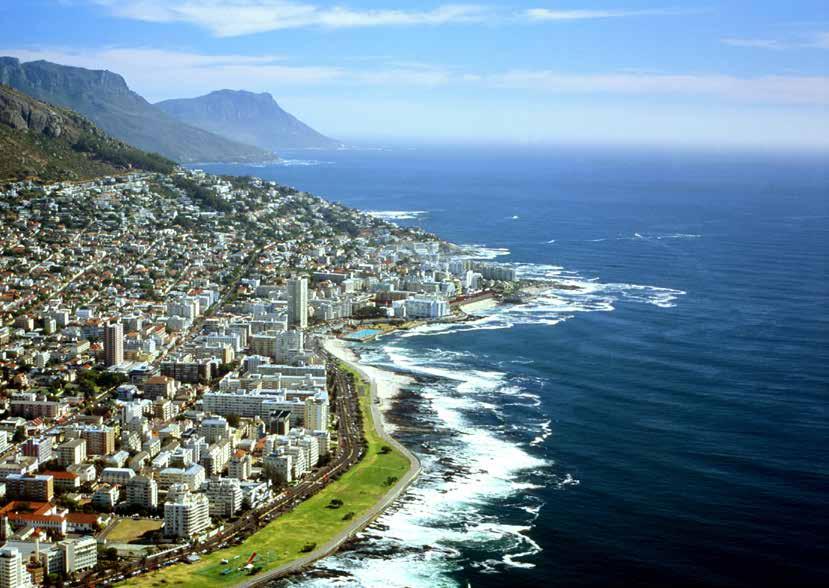
in subsea environments. “Piping systems with Victaulic grooved products feature a 40% to 60% reduction in installation manhours over alternative joining methods and leverage a worker skill base that can be quickly trained and globally available, greatly reducing the potential for schedule delays,” says Ley.
The Santa Barbara desalination plant now produces nearly 12 million litres of potable water per day.
Ley argues that, in a situation such as the one experienced in Cape Town, we cannot afford to overlook the opportunities presented by desalination plants and technologically advanced solutions. “Imagine, for a moment, the notion of taps never running dry again.”

The upgrade of Point Watermain, which got under way in February 2020, will see the construction of a 4.1 km long DN 800 steel pipe along Anton Lembede Street and Mahatma Gandhi Road. Expected to create numerous job opportunities, the R190 million project is planned for completion in June 2021.
According to Nasreen Arabi, senior programme manager: Catalytic Projects Unit, eThekwini Municipality, the Point Watermain upgrade project forms part of a response to the Inner-City Regeneration Strategy based on the Inner-City Local Area Plan (LAP). It is also a response to the dilapidating infrastructure that requires upgrading for future growth of the area.
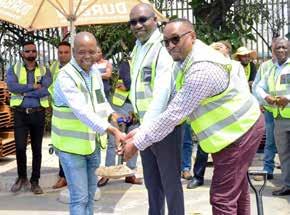
EThekwini’s Economic Development and Planning Cluster Deputy City Manager, Phillip Sithole, Mayor Mxolosi Kaunda and City Manager Sipho Nzuza mark the beginning of the redevelopment of the Point Precinct
The current water demand for the Durban inner city is 28 Mℓ/day. Future flow from the Point development will add another
3.5 Mℓ/day. The development is also considered a high-risk area with respect to the provision of water for firefighting due to the proposed high-rise buildings, thereby exaggerating the peak flow.
The 2040 future demand allowing for the planned Inner-City Regeneration is 50 Mℓ/day. Council understands that it is unlikely that the Montille Reservoir and lower Umgeni system will meet this future demand, so alternative and innovative supplies are being considered by eThekwini Municipality, including a Remix Plant (recycling plant) situated at the Central Wastewater Treatment Plant across the harbour entrance on the Bluff. Potable water can be reverse-fed from this Remix Plant across the harbour tunnel and into the bulk supply main along Mahatma Gandhi Road and into the Durban inner city. In order to accommodate this alternative, a marginal increase in the optimal pipe size for the bulk main along Mahatma Gandhi Road has been made.
The pipeline is situated within the water table in an aggressive saltwater environment. Special protection to the pipe coating, together with cathodic protection, is required to prevent corrosion of the steel pipeline.
Furthermore, the pipeline is constructed within a roadway that consists of numerous existing services (sewer, stormwater, electrical), requiring both a challenging horizontal and vertical design to avoid the relocation of these services. This has resulted in deep concrete chambers for valves that will all have to be constructed with the roadway. The deep vertical alignment will, in places, require the dewatering and shoring of trenches in excess of 3 m deep during construction.
eThekwini Municipality has begun work on the upgrade of the Point Watermain in order to facilitate the development of the Durban Point Waterfront and meet increased demand.
The city committed to upgrading the bulk infrastructure watermain as well as the public realms in order to support future development and establish the Point Precinct development as a world-class facility. Currently under way, the publicprivate sector project to revitalise Durban’s Point Waterfront forms an essential part of eThekwini Municipality’s initiative to redevelop and regenerate the inner city. Durban Point Waterfront has long been identified as critical to both the retention and growth of Durban’s tourism industry. To this end, eThekwini Municipality, in partnership with the Durban Point Development Company, is working to revitalise the precinct.
The R35 billion investment located on the South Point of the central beachfront is set to include several mixed-use developments, including upmarket residential and commercial developments, a retail mall, a hotel and leisure facilities. This will be undertaken in three phases over 10 to 15 years.
“This initiative must be seen in the context of a city-wide development process, indicating that Durban is on the brink of change, that there is significant interest in the revitalisation of the CBD and the Point Precinct,” says Arabi.
Approximately 11 000 constructionphase jobs are likely to be created per annum during the Point Precinct project, as well as 6 750 permanent jobs.

utting the WISA 2020 theme of #AllHandsOnDeck into action, the conference organisers have secured new dates for the region’s biggest water event. The conference will now take place in the same venue – Sandton Convention Centre –from 6 to 9 December 2020.
After a period of slowing down and isolation, all indications are that this December is going to be a time of regrouping, reconnecting and starting afresh – a perfect time for the sector to work together for water.
Pending confirmation, WISA 2020 will be going ahead with the same excellent sessions and speakers. The extra time also allows the organising team to ensure that the conference is bigger and better than ever before.
What to look forward to
The first half of 2020 has not only highlighted the importance of good hygiene, but it has also reinforced the message that societies are unable to maintain their health and safety without an uninterrupted supply of clean water.
Southern Africa is facing a growing water crisis worsened by insufficient water infrastructure maintenance and investment, recurrent droughts and floods driven by climatic variation, inequities in access to services, deteriorating raw water quality, and a lack of skilled water practitioners.
In order to address these challenges, WISA is calling for #AllHandsOnDeck, and WISA 2020 will provide a platform for these issues to be discussed, solutions shared, and decisions taken in a pledge to action.
In line with this call to action, the conference will focus around six sub-themes:
1. Reduce water demand and increase supply
2. Manage the resource for a capable ecology
3. Manage and monitor effective water
and sanitation services and infrastructure
4. Govern and regulate the sector
5. Improve raw water quality and management
6. Develop skills and technology innovations and disruptors.
#AllHandsOnDeck calls for local and regional players to work together towards a sustainable water future, and WISA 2020 aims to speed up delivery and bring purposeful feedback to the leadership of South Africa.
Water is as important as it has always been, and with the potential economic fallout of the novel coronavirus, South Africa needs #AllHandsOnDeck.
To learn more about the conference, visit www.wisa2020.org.za.
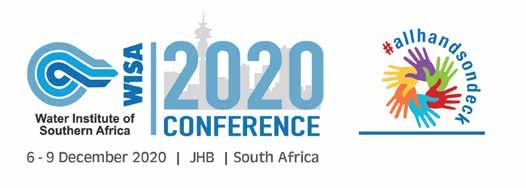



Charné Millett-Clay

Carolyn Melnick
Sponsorship & Exhibition Manager Project Manager
Tel: 011 463 5085
Email: charne@soafrica.com

Tel: 021 422 2402
Email: caro@soafrica.com


The Dynasand Continuous flow filter is a well proven technology augmented by the latest water filtration innovations consisting of an Open Vessel with low head. Water can be pumped into the system, or should the location allow, be fed by gravity. It runs by simple operation without any moving parts. In addition, the need for back wash pumps and operations is eliminated. Only air is added to the air lift pump, resulting in a highly reliable and consistent filtration quality. There is no “first filtrate” and there is no filtration interruption for back-washing. Continuous Contact filtration occurs, and no pre-sedimentation is required where incoming flows have a turbidity of up to 60 NTU for potable water. Footprint is also reduced by up to 50%, due to the higher capacity per unit of filter area.

